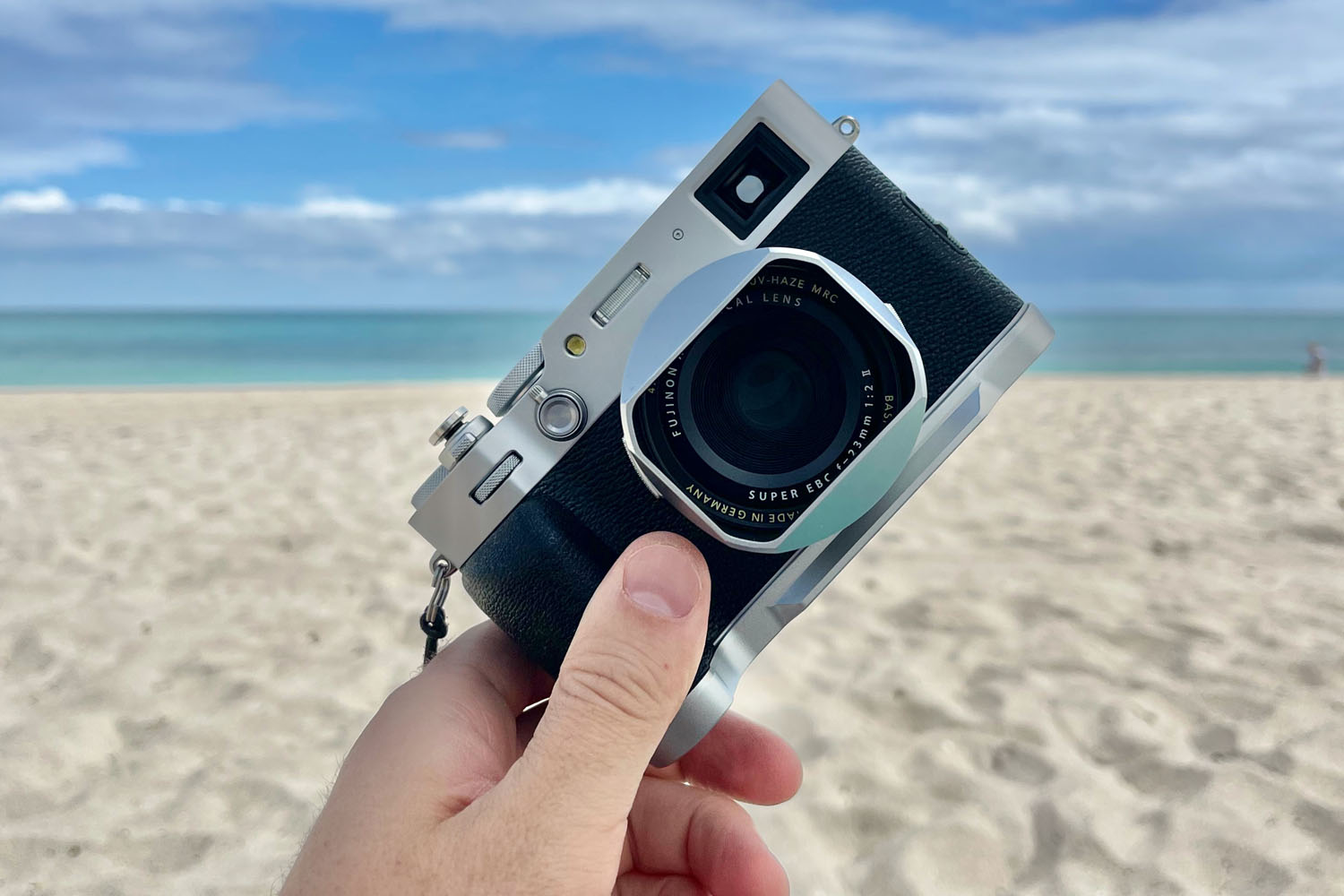Made by the Sea – Adventures in Portugal
Schist Houses of Talasnal
In the interior of Portugal, about an hour from Coimbra and 30 mins up a steep winding road from Lousã, is the old town of Talasnal, comprised entirely of schist houses, where “schist” refers to flat rock slabs stacked and assembled into homes. People have been building like this here since around 1200 AD, but this village has evolved continuously, sometimes falling into disrepair, then rebuilt. At one point in the 70s, the village was almost entirely abandoned and occupied by hippie squatters; now it’s an AirBnB and European vacation haven.

Schist houses illuminated by evening street lamp below our balcony.
I was in Portugal with family for a make-up trip – we had been short-circuited at the airport the previous year because there were only three months left on our passports, and most countries require your expiration date to be six months beyond your travel dates. Thanks for telling us in advance, airline! That setback was a bummer, but this time around, our passports were fresh and nothing was going to stop us.

Wandering streets and alleys of Lisbon with Amy and Miles
I’m Scot Hacker, a cyclist, hiker, and photographer from the east side of the San Francisco Bay Area (“East Bay”). I work by day as a Python/Django developer (programmer), but spend most of my free time exploring and adventuring, always with Fujifilm cameras. I’ve had a series of “simple” cameras and have photographed casually most of my life, and did a few years of Photo365 projects with an iPhone, but only picked up a real camera and started to do manual exposure and editing at the start of the pandemic, when I discovered that my hiking and cycling hobbies were even more satisfying when I had a camera with me; now I rarely leave the house without one.
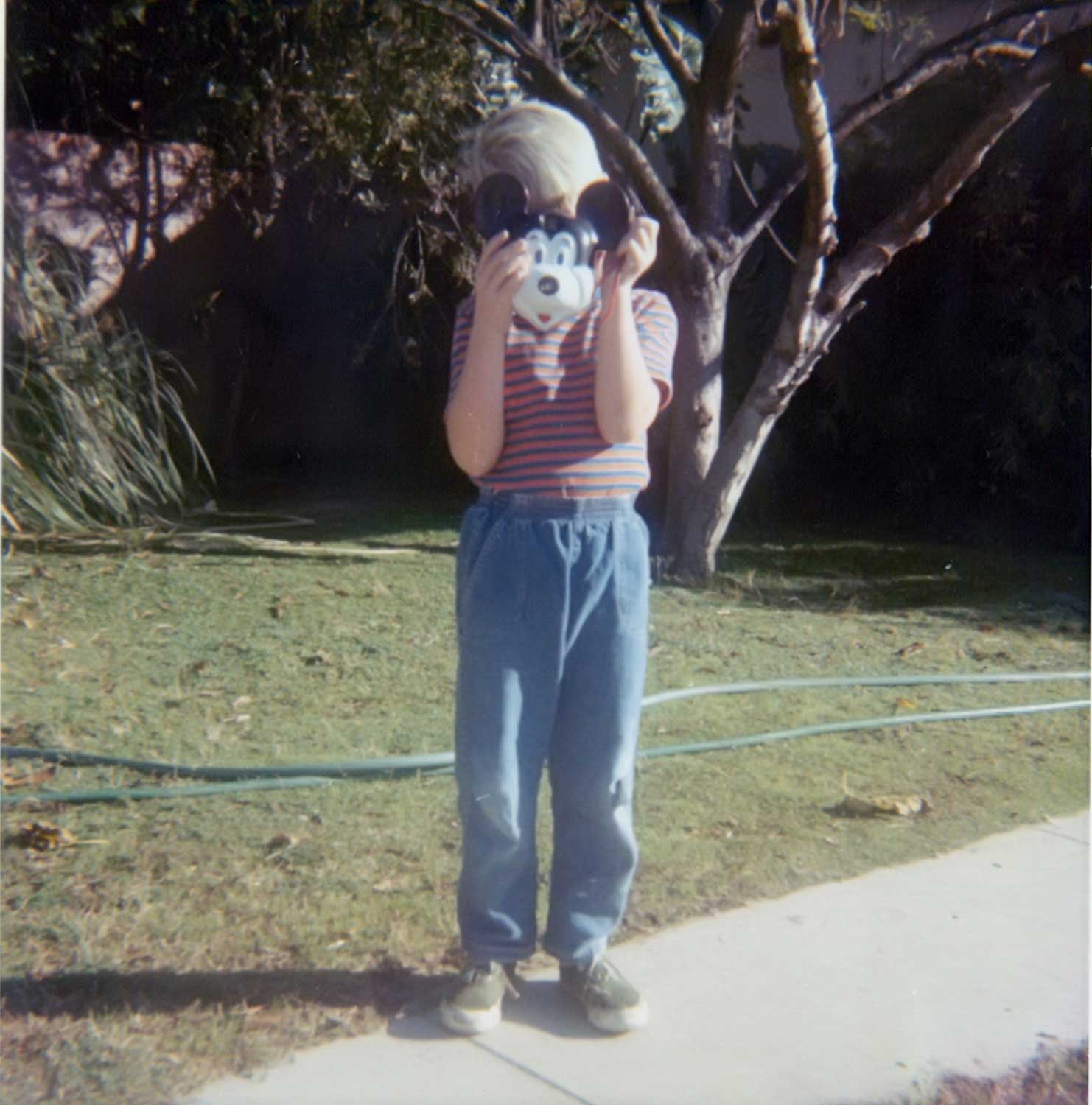
Gear
Portugal is a photographer’s paradise. Tiled houses and buildings, patterned cobblestone streets, beautiful decay everywhere you look, and (in the Azores) volcanic geography coupled with lush jungle. And there’s a long history of proud workmanship – you can see the time and love that workers have poured into not just the function of public infrastructure, but the form as well, down to small details.

Lisbon train station
I was traveling with my trusty Fujifilm X-T4 and four lenses (which, yes, is a bit nutty, but I used them all):
● Fujinon 16-80mm f4 – My most versatile lens and the one I’ve used more than any other (it’s my “glued-on” lens)
● Fujinon 16mm f1.4 prime – My clearest lens, perfect for night photography and pellucid landscapes
● Fujinon 23mm f2 prime – small and light, a favorite for street stuff
● Fujinon 30mm f2.8 macro – I purchased this for macro purposes but it turned out to be a fantastic walk-around lens
I also have an X100F, on which I first learned manual exposure and got turned onto the Fujifilm experience, but now it’s just my cycling camera (I carry it in a bag on the bike’s top tube while exploring the gorgeous Bay Area environments of Point Reyes, Tomales Bay, and Petaluma). But most of the time, it’s the X-T4 that follows me everywhere. I’m currently looking for an older Fuji body I can have converted to infrared.
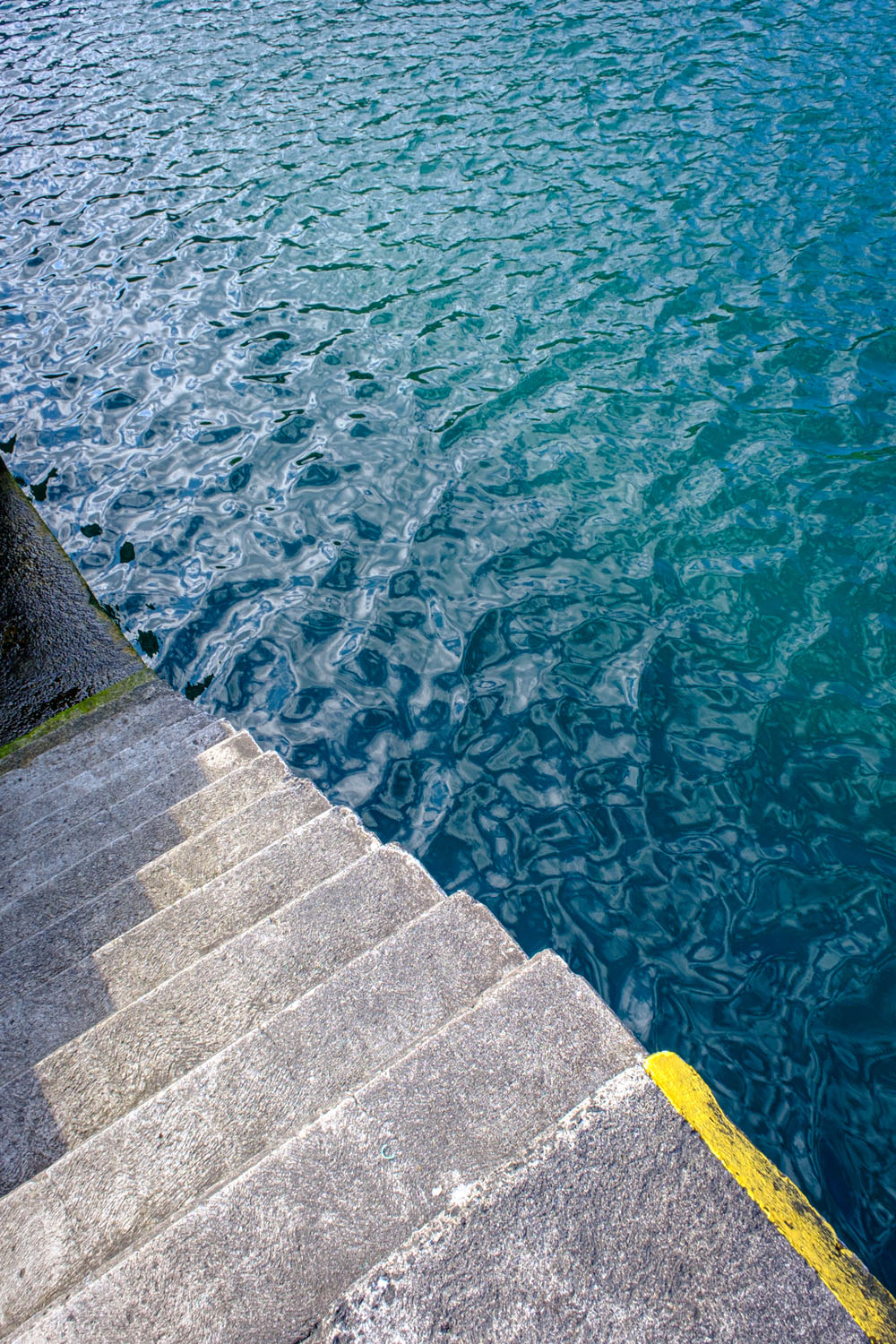
Descent – stairs and sea, Povoação
“If there is one portion of Europe which was made by the sea more than another, Portugal is that slice, that portion, that belt. Portugal was made by the Atlantic.” – Hilaire Belloc
I debated whether to take the Peak Design tripod. It’s a bit of bulk and weight I didn’t look forward to lugging around, and I often don’t end up using a tripod on trips at all, but I did find a few uses for it and was glad I had it in the end.
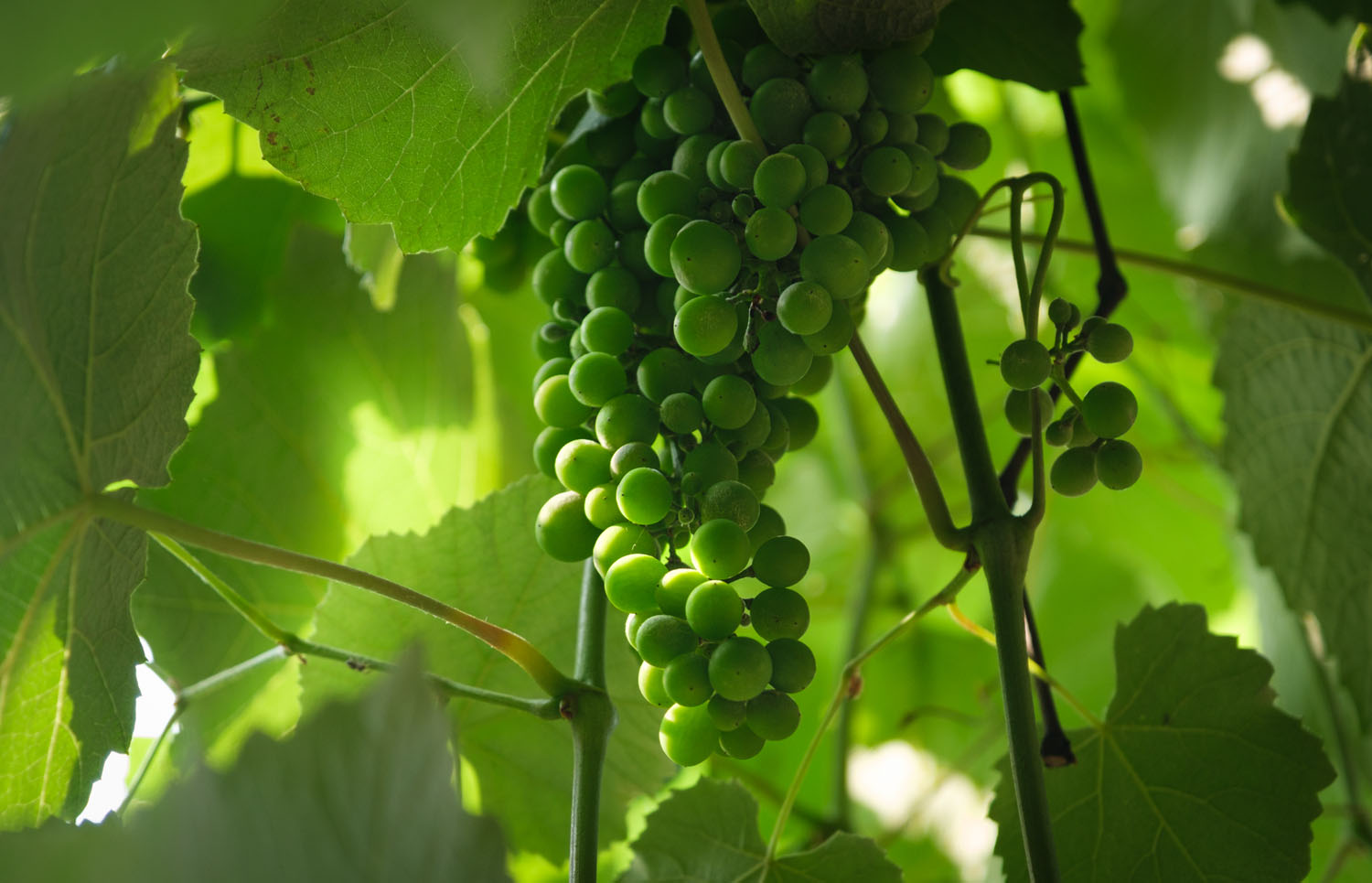
Wild grapes in Talasnal
My camera bag is the Peak Design 20-liter “Everyday Backpack” with Capture Clip (which I move over to the full backpack when I’m backpacking). You’ve heard it before but I’ll say again: Nothing has revolutionized my photography more than that $75 Capture Clip. My relatively lightweight mirrorless gear hangs lightly near my left shoulder, and the camera is always at hand.

Miles chilling on a footbridge in the forests of Talasnal
After clipping and unclipping thousands of times, I can grab the clip’s release bar, power on, and have a shot in two seconds flat if I don’t need to make exposure changes. That gives me the flexibility to grab just about anything on-the-go, without planning, and that’s the style of photography I’m most comfortable with – spontaneous and fluid (though I have been continuing to practice the art of slowing down and composing with a more meditative mindset as well).

Cock-eyed streetlight in Ponta Delgada
Tile and Cobble
Portugal is famous for its hand-laid cobblestone streets and sidewalks (black and white limestone, plus cobalt) and ornately tiled buildings. Some are fresh, some are aged and decrepit, but there are amazing visuals everywhere. A lot of it carries the mark of the era it was created in, from Spanish Colonial to pop art, b/w to vivid color. Apparently the patterned cobblestone was initially laid to create a welcome path for the king as he visited various cities, but it became a tradition and point-of-pride for craftspeople.
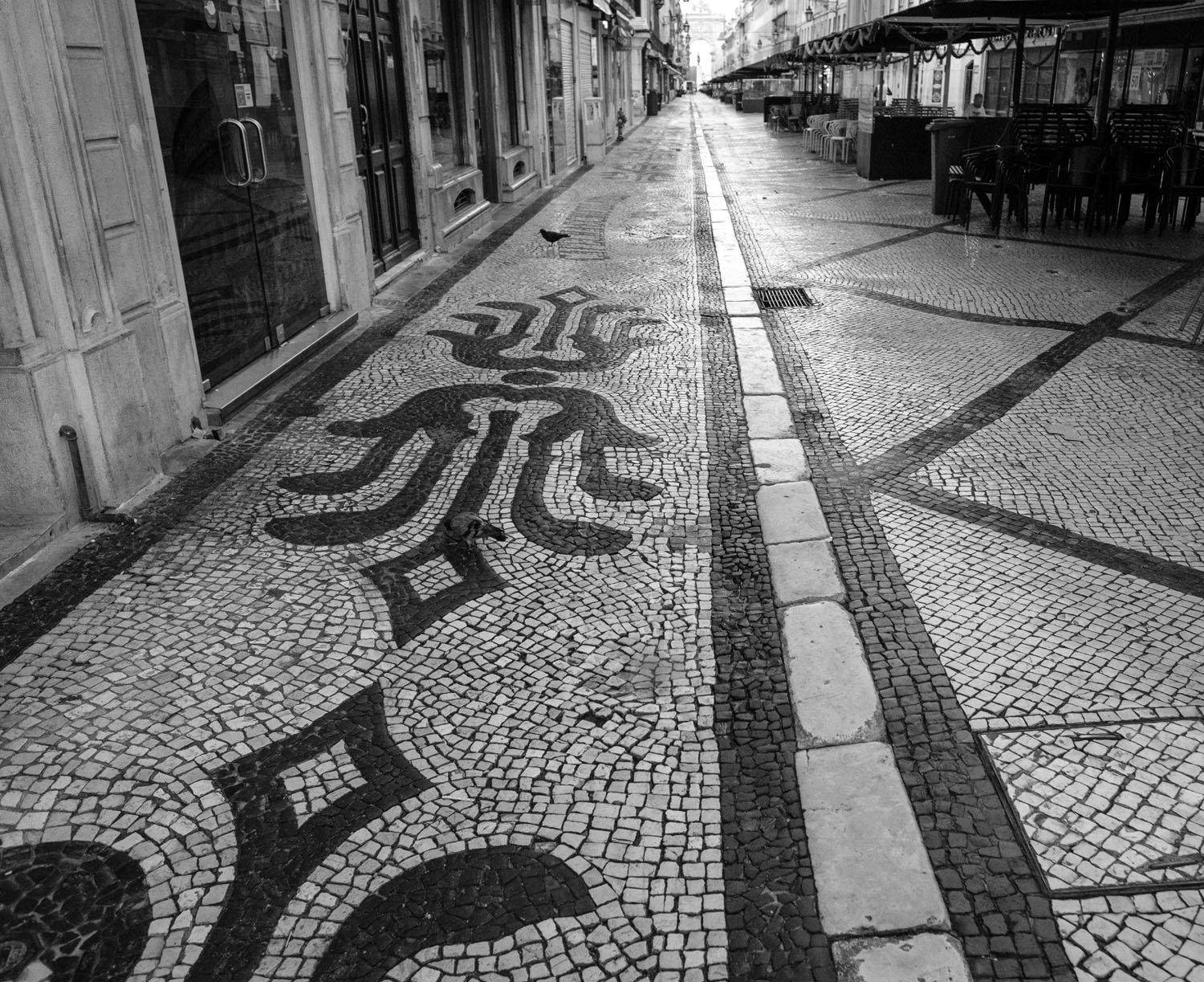
Tiled cobblestone, downtown Lisbon
“In the Middle Ages, Spain and Portugal were so powerful that they signed a set of treaties literally dividing up the globe between them.” – Max Fisher
Many (most) buildings and houses are covered in unique decorative tile that preserves the aesthetic of the era in which it was created – Rococo, or Art Deco, or Pop Art, or Regal, or Business-casual. Some of it fades, some remains vivid, and there’s nothing to “organize” it – just the randomness of each neighborhood’s evolution. The chaotic result reflects the history of each city’s evolution.
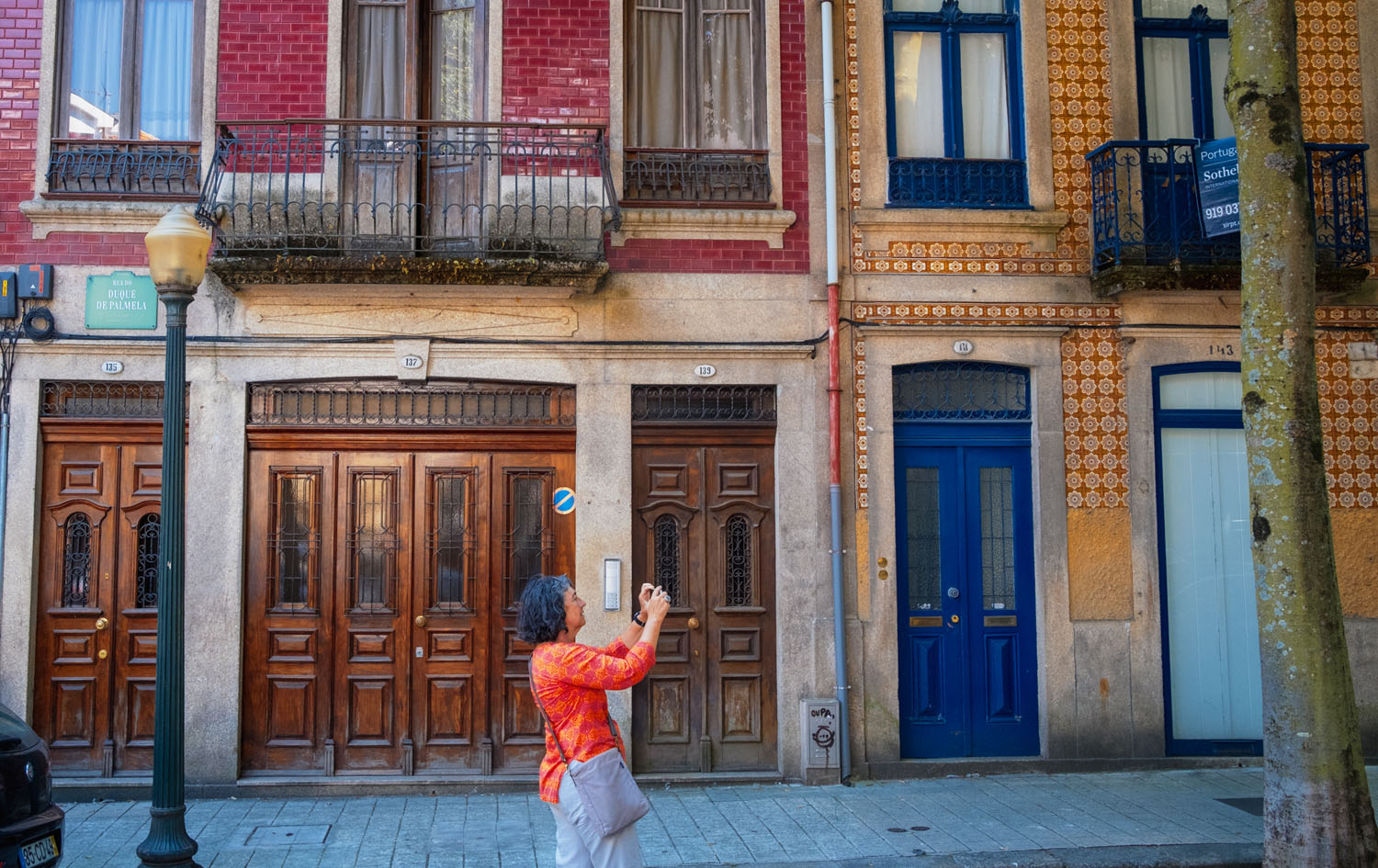
Amy with tiled facades, Porto
Beautiful Decay
Americans are allergic to decay. When something “feels old,” we tear it down and put up something generic in place of the old beautiful thing. In Portugal (and throughout much of Europe), it’s not that simple. There’s less incentive to modernize, less money to go around, and in a lot of cases, laws restrict what you can do with buildings of a certain age which are considered “historic.” So they end up in this situation where buildings are too old to be useful or safe, but they also don’t have the means to tear them down, or aren’t allowed to.
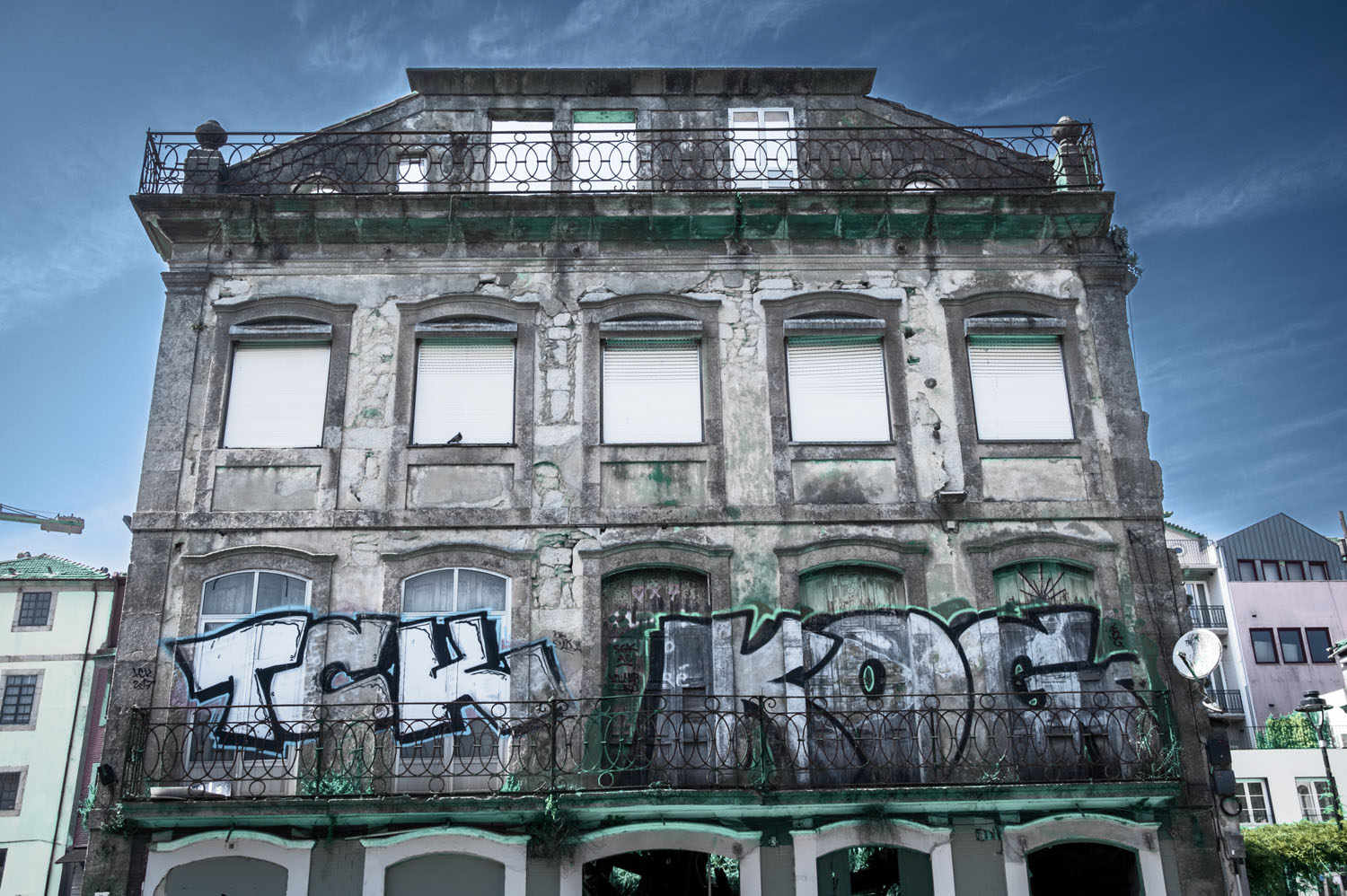
Beautiful decay, somewhere in Porto
Nature slowly takes over. Weeds and moss grow on the floor and up the walls, windows break, and graffiti is inevitable. And there’s something about exterior paints that tend to fade and run over the decades, creating organic accidental artworks I’d never seen on buildings before. They become part of the visual texture of the country, and I couldn’t stop taking pictures of “beautiful decay.”
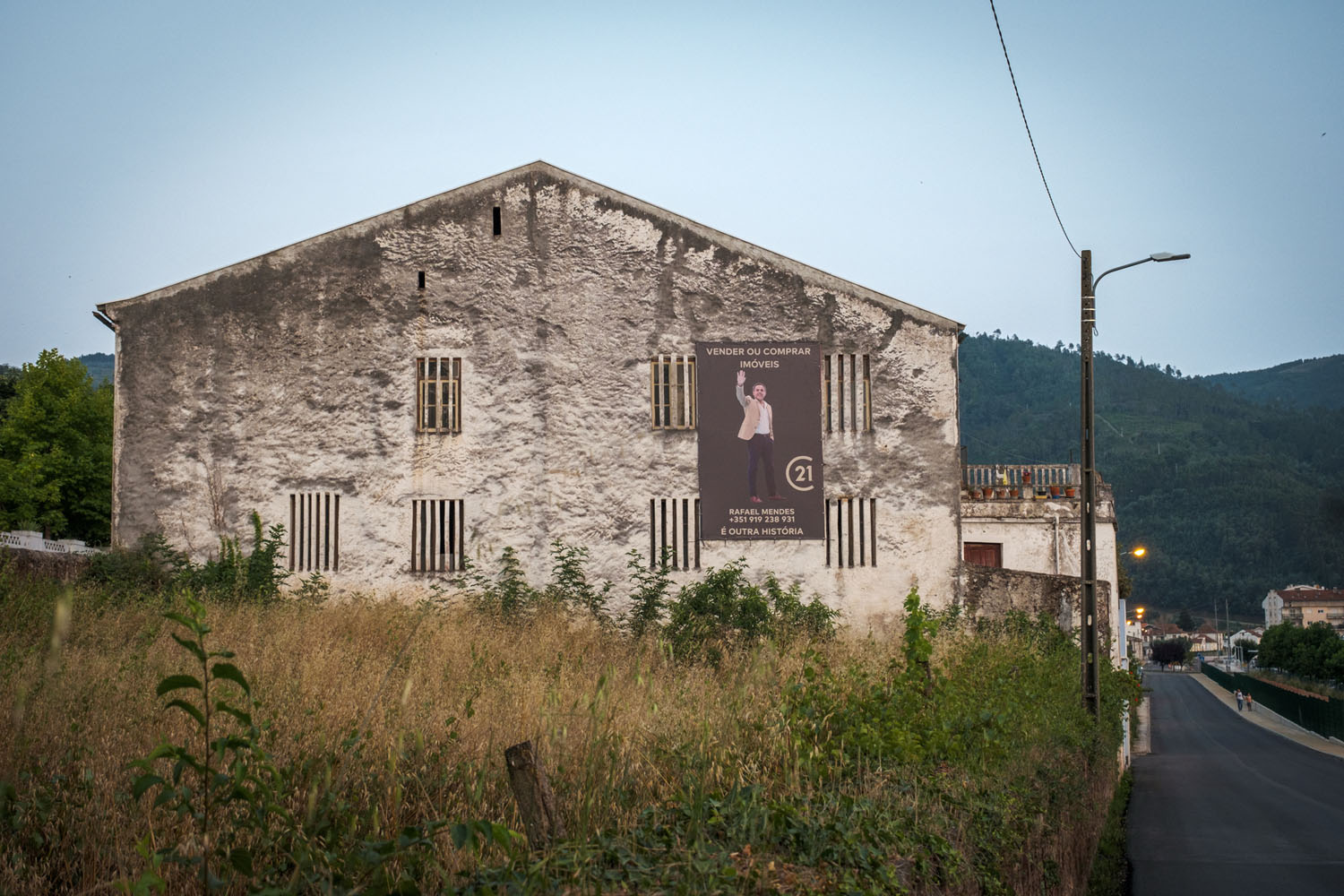
Accidentally textured paint, Lousã
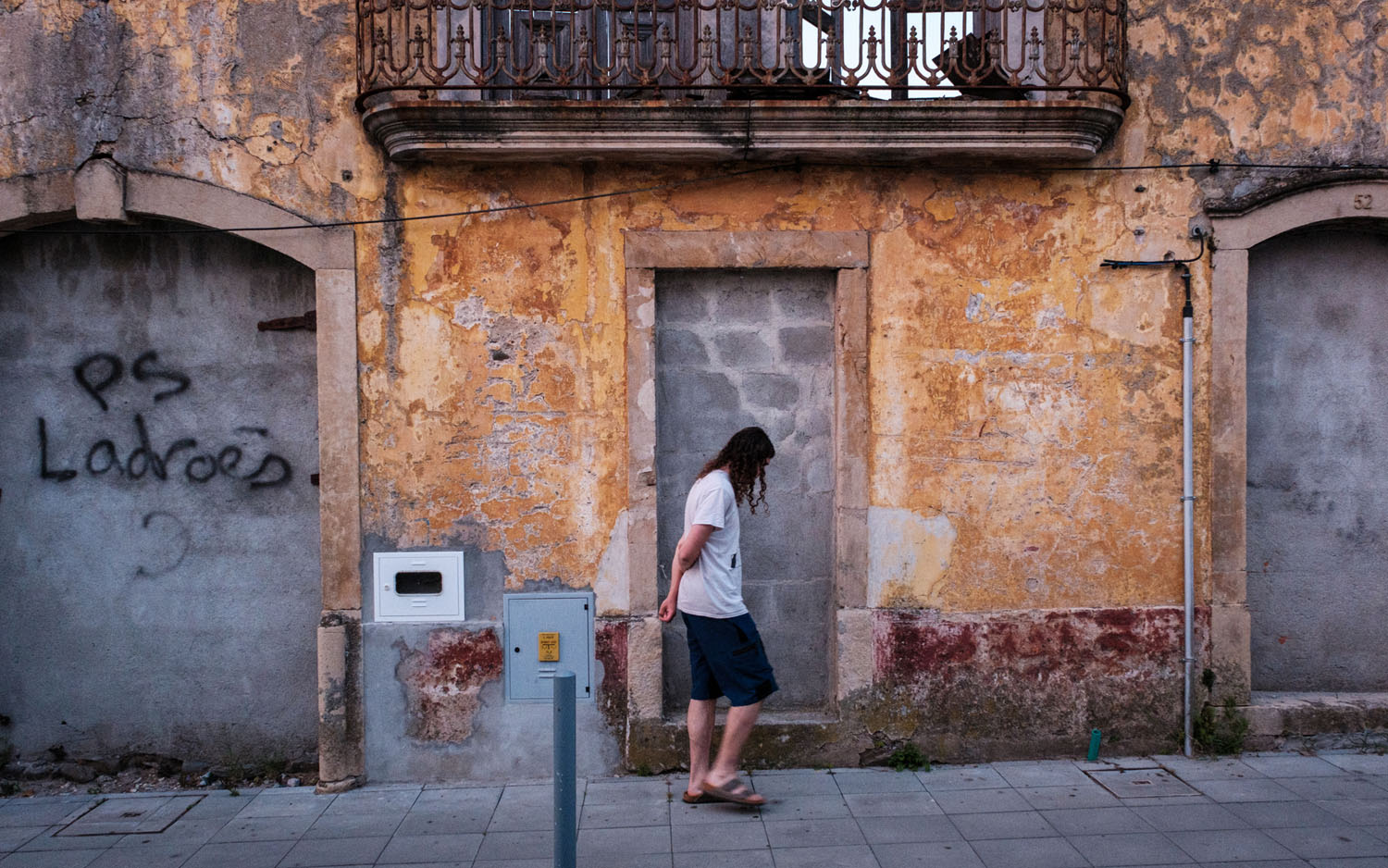
Walking with Miles amongst urban ruins in Lousã

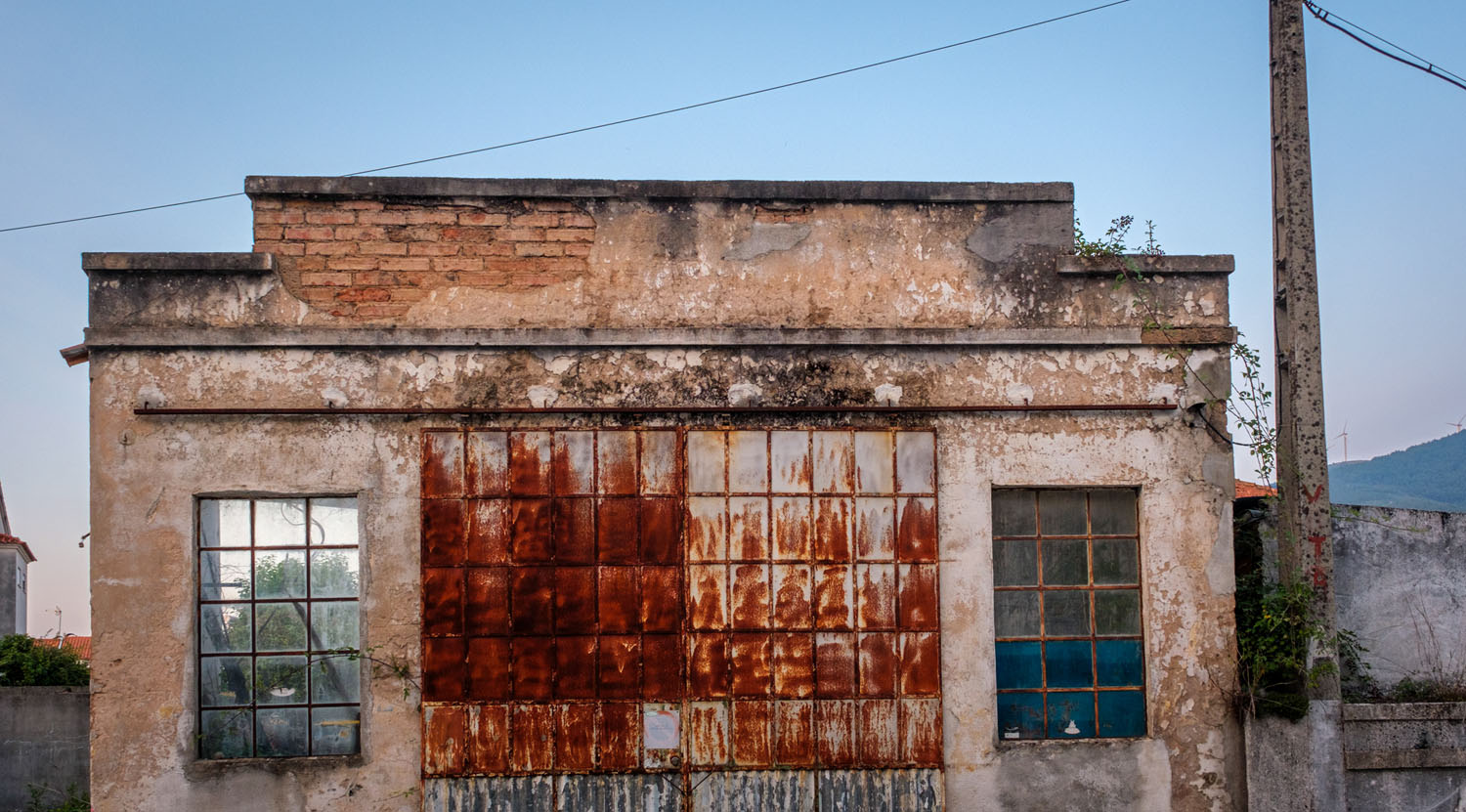
Lisbon apartments, no longer occupied
RIGHT: Fuji X-T4 . Fuji XF16-80mmF4 @18.40mm . f/5.6 . 1/125″ . ISO 500
Rust never sleeps
Train Strike, MAAT

Scrambling to catch a taxi for the late train, our family found ourselves reflected in the windows of a government building, with the Tagus River behind us.
After spending the first day in Lisbon, we’d intended to head straight for Porto by train the next morning. But the train was late, and then later. It was still listed on the Arrivals/Departures board, but no train was coming. Finally, we went to the ticket booth to find out what was happening, and the employee explained that there was a train strike in progress, and that the only train that would be running that day wouldn’t depart until 10pm. Of course there was no announcement, no sign, no nothing. People told us later that this was typical of Portuguese train systems.
The culture just has a more laissez faire attitude toward things not working out. “If it comes it comes. If it doesn’t, go do something else” It was hot, so we decided to while away the day at a museum. Specifically, Lisbon’s Museum of Art, Architecture and Technology (The MAAT), which is housed inside of defunct electrical power plant from the 1920s that has been painstakingly restored. The plant seemed to go on forever, room after giant room full of century-old equipment in nearly perfect nick. Scattered throughout were displays of art and industry. The two environments (electrical plant and art museum) were really nicely integrated.
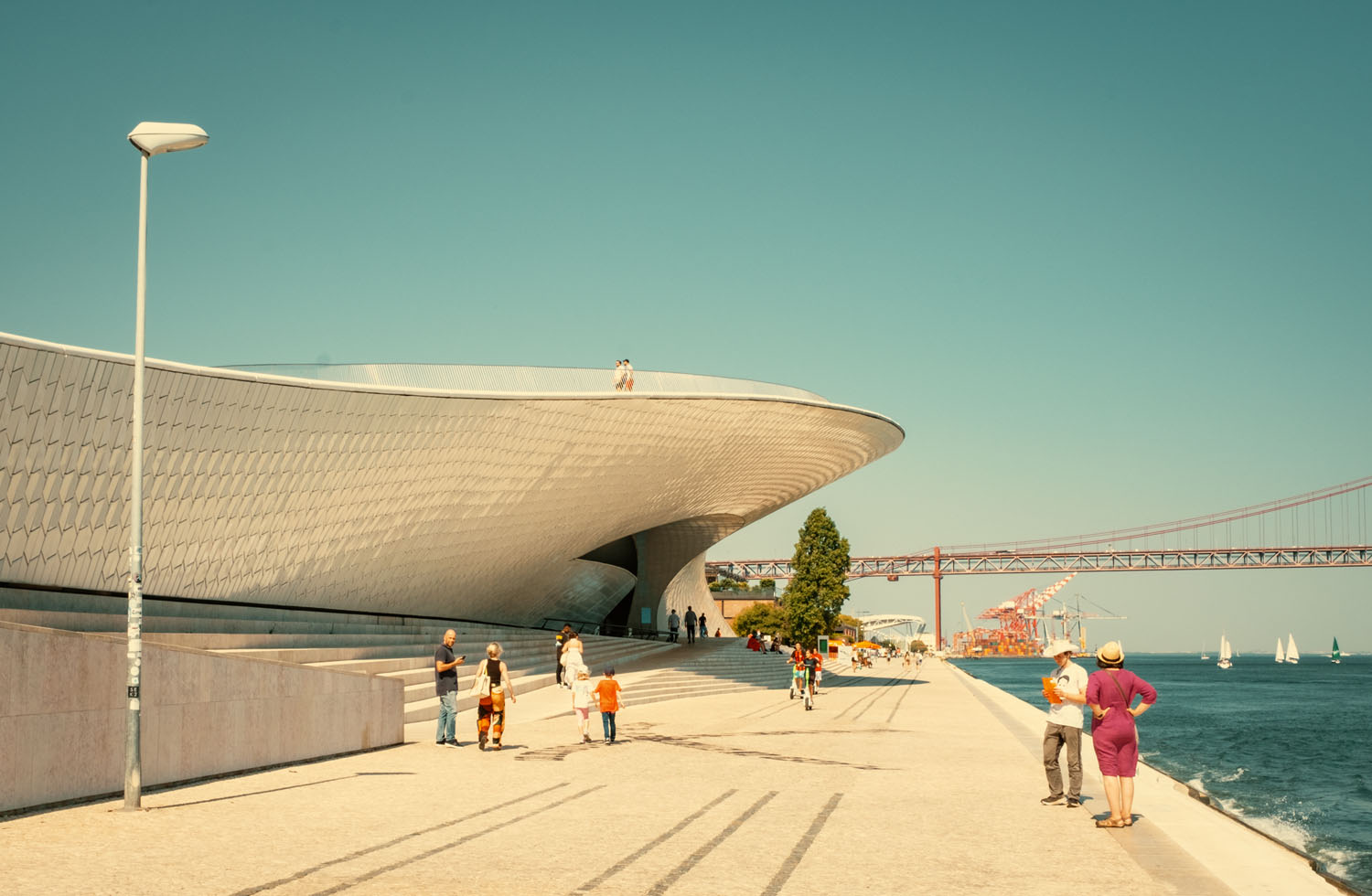
The Museum of Art, Architecture, and Technology (MAAT), Lisbon


Old cooling pipes in the MAAT
RIGHT: Fuji X-T4 . Fuji XF30mmF2.8 Macro . f/16 . 1/125″ . ISO 2000
Miles in the MAAT, looking out onto Lisbon
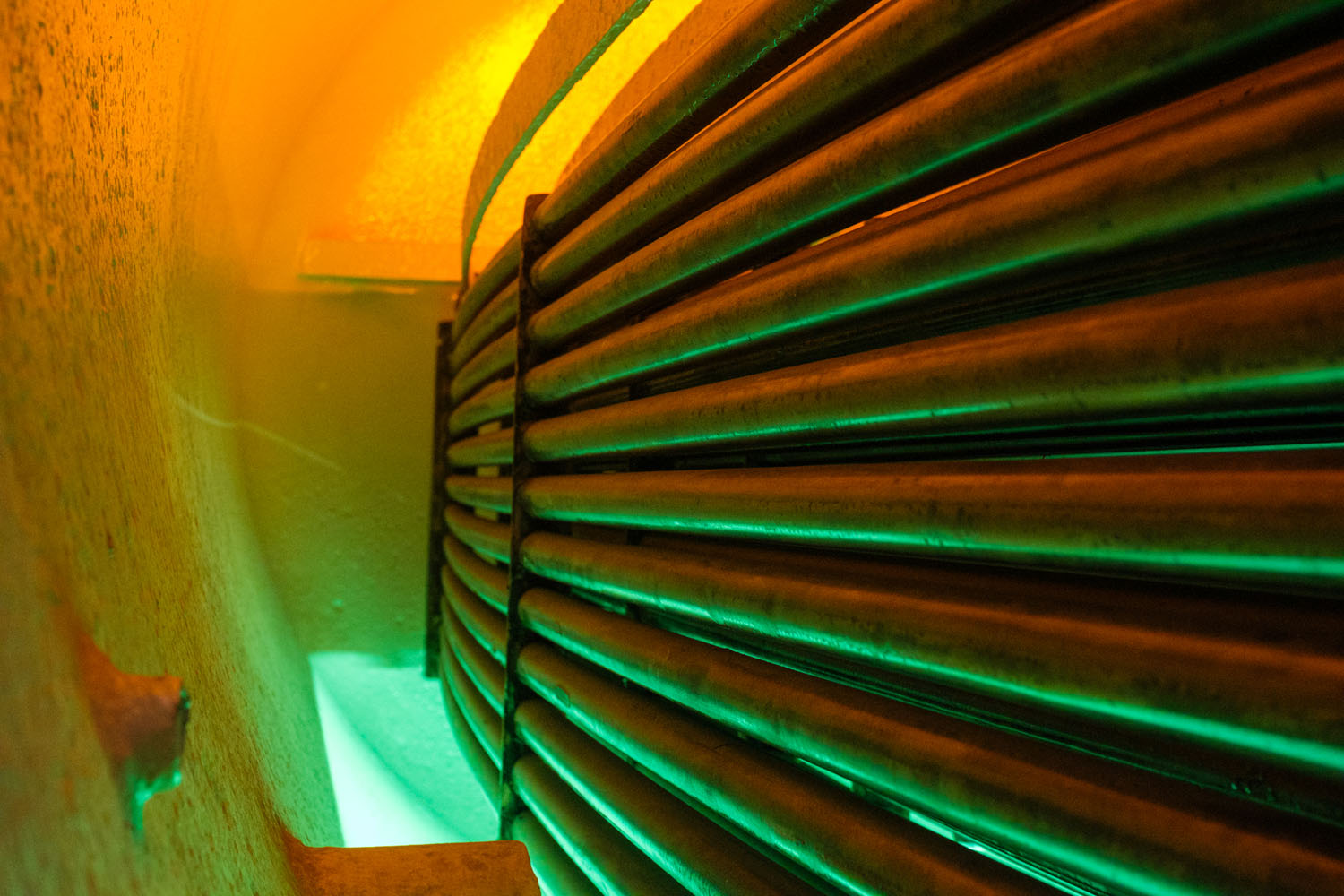
Peering into ancient infrastructure at the MAAT
The night train was slow and crowded, and we didn’t pull into Porto until after 1am, bleary and hungry. But as we emerged from the station, we heard a cacophony of squeaking sounds, and found drunken locals reveling in the streets. As we dragged our rollie suitcases over cobblestone about a mile into the heart of Porto, the reveling didn’t stop, and strangers kept bonking us with their plastic hammers, which made a cartoonish “Honka Honka” sound. My son and I loved the surrealism of it all. We later learned we had arrived just as the multi-day “Festa de São João” was wrapping up, and that this was its final hurrah.

Street vendor selling plastic accordion hammers for bonking strangers on the head, Porto.
People
We loved meeting Portuguese locals from every walk of life. Here’s a random smattering of citizens doing their own things (and a few tourists), sometimes candid, sometimes posing.

Fatima Francisco, enthusiastic to have her picture taken on Lisbon’s funicular climb. Wild billowing pants!


Teens at an outdoor pool, Lisbon.
RIGHT: Fuji X-T4 . Fuji XF23mmF2 . f/5.6 . 1/125″ . ISO 400
Tuk-tuk driver, Lisbon
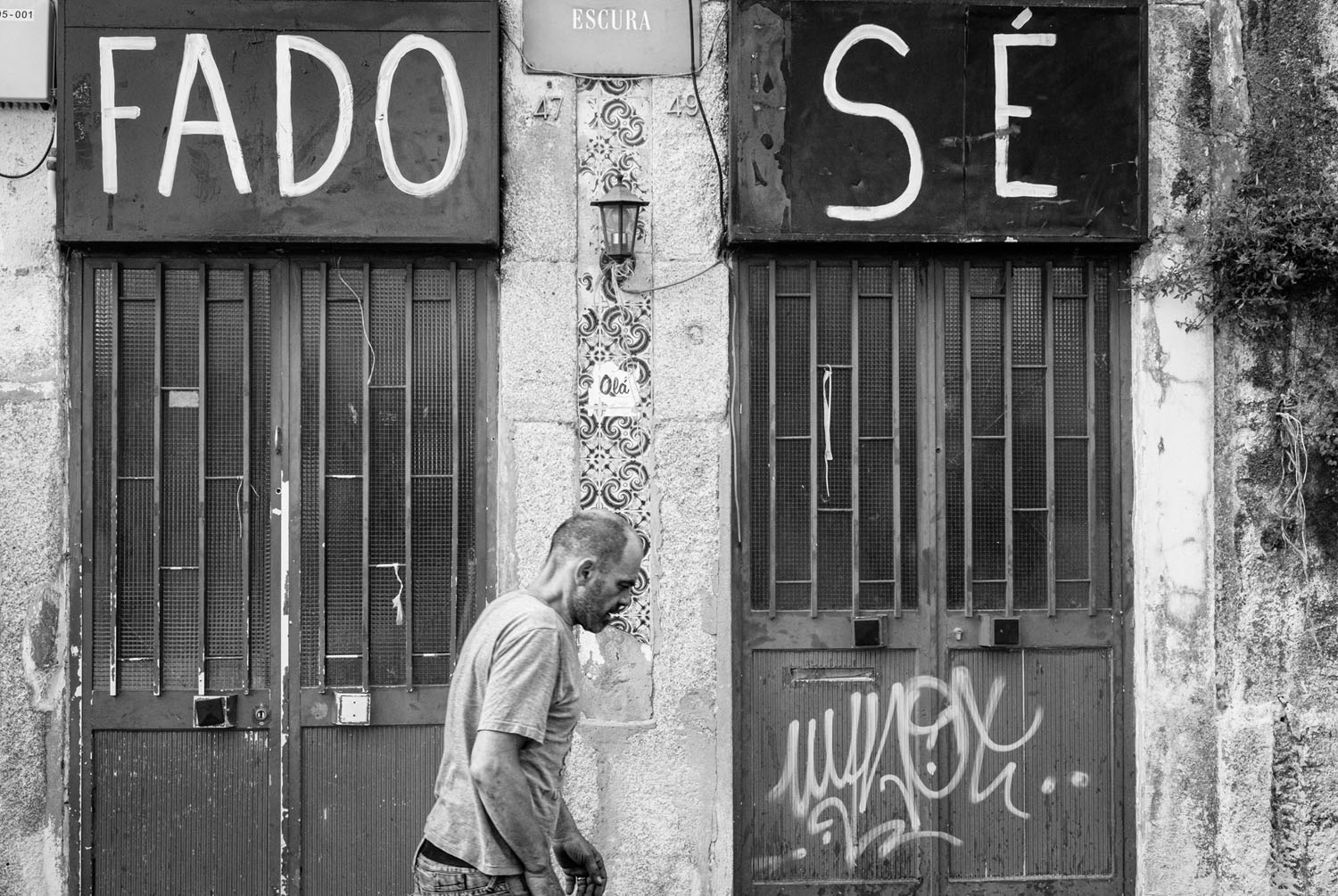
Citizen in front of an abandoned Fado restaurant

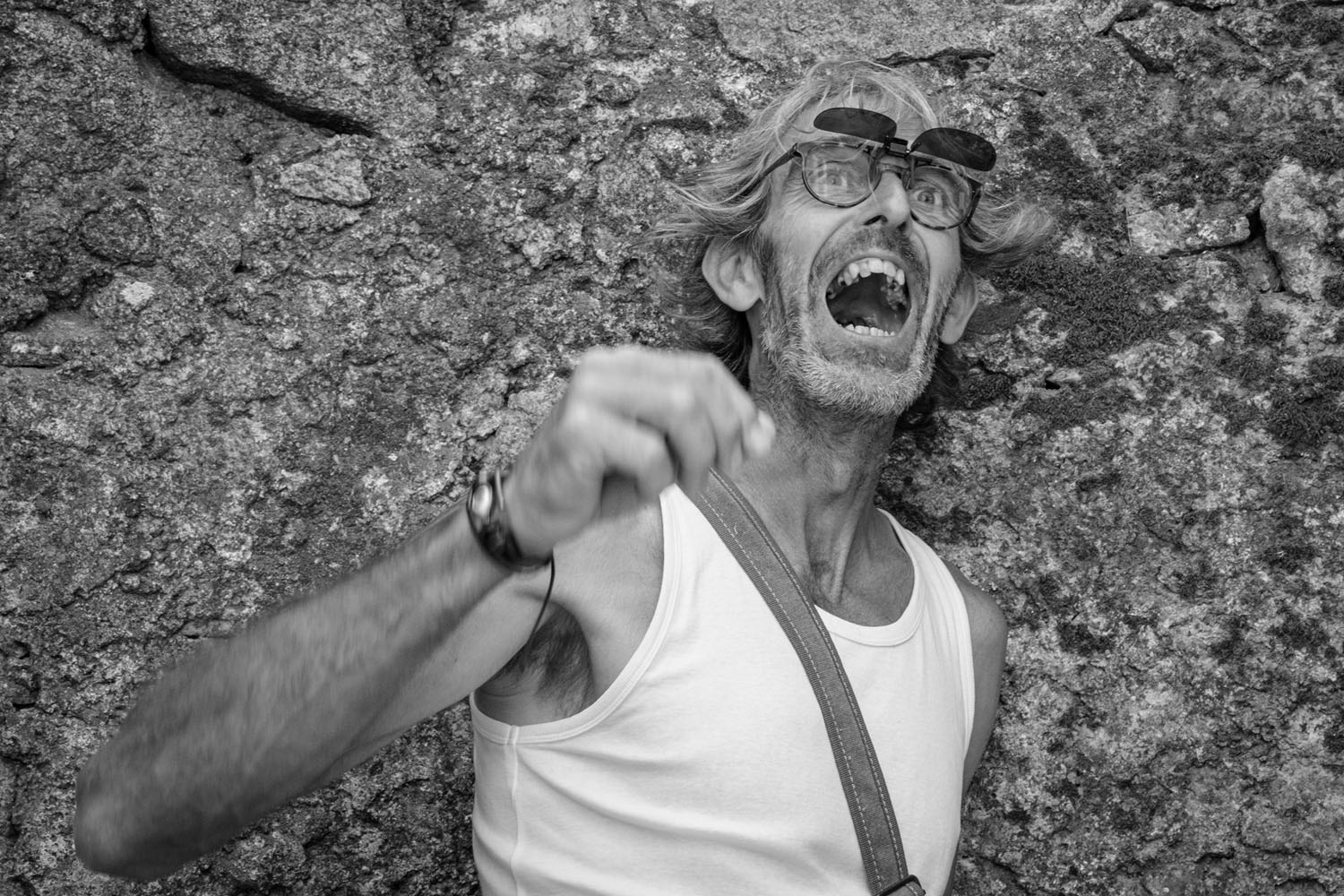
Bazouki player at Sintra
RIGHT: Fuji X-T4 . Fuji XF16-80mmF4 @32.50mm . f/5.6 . 1/250″ . ISO 640
Nutty German tourist I encountered in the castle at Sintra
“The only thing that matters is to feel the fado. The fado is not meant to be sung; it simply happens. You feel it, you don’t understand it and you don’t explain it.” – Amália Rodrigues
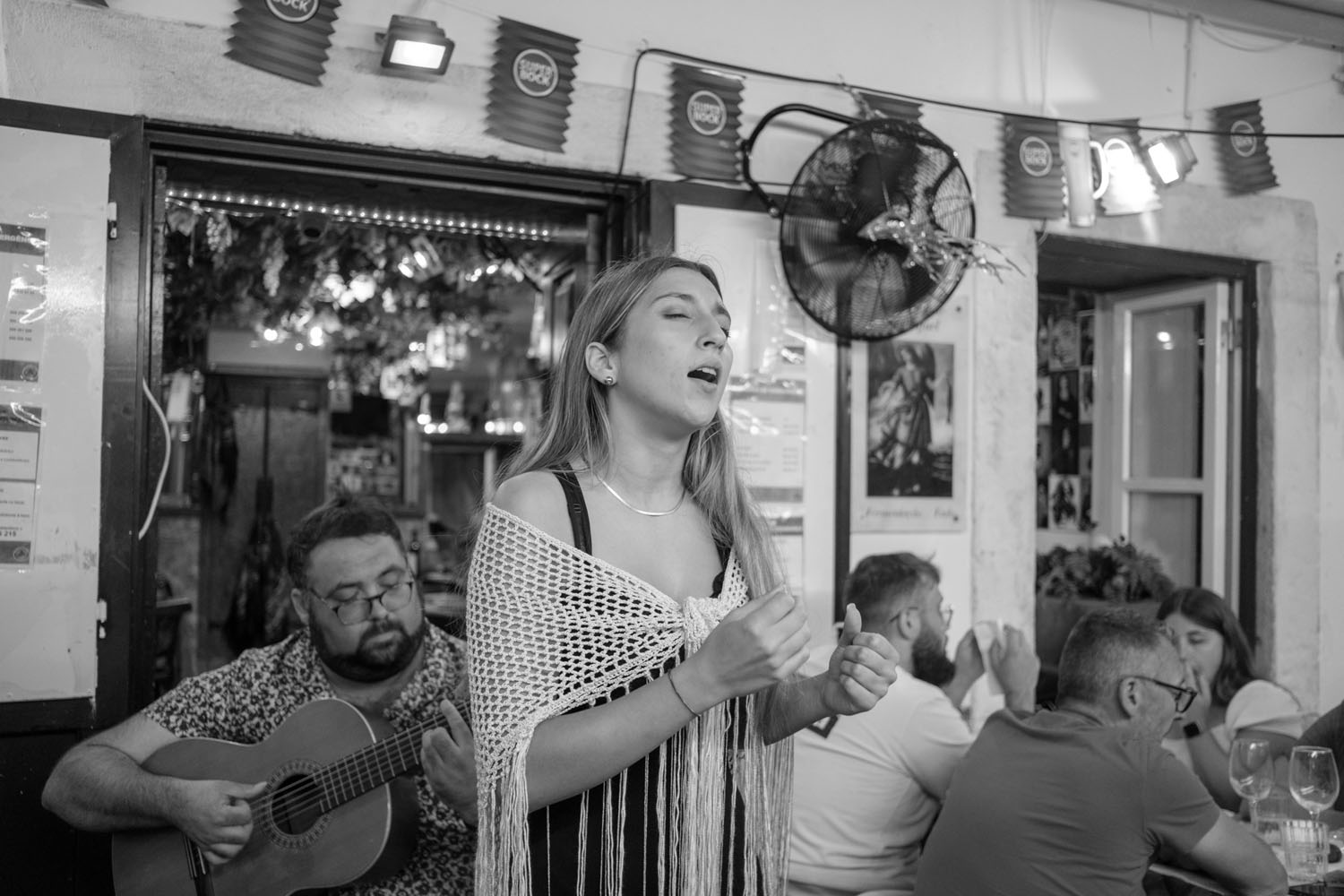
Fado singer at a Lisbon restaurant.

Old-school wagon driver, encountered when we took the wrong exit.
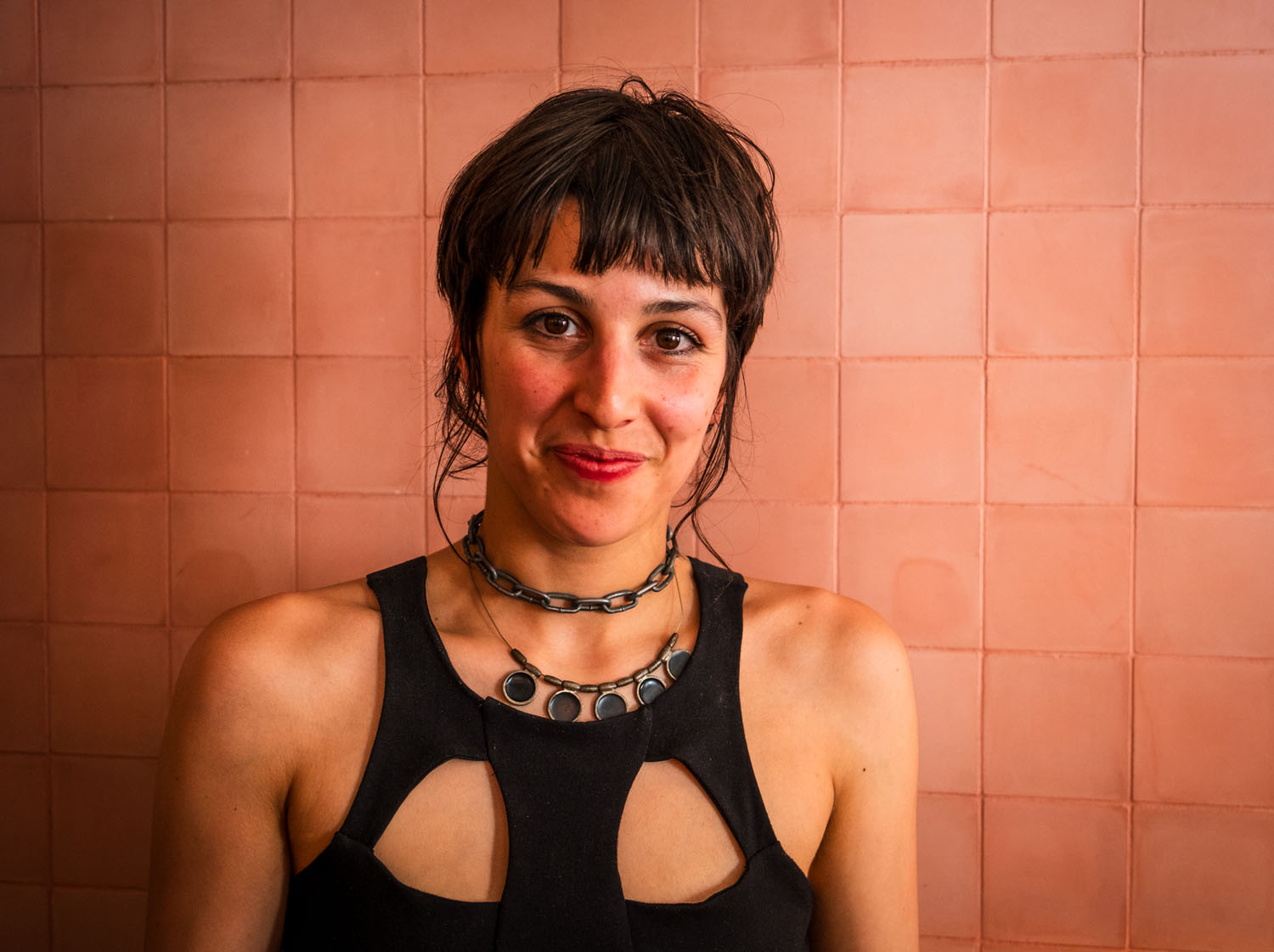
Barista at the Museum of Photography, Lisbon
Nazaré and Óbidos
“Oh, salty sea, how much of your salt Is tears from Portugal?” -Fernando Pessoa
On the way from Porto to the airport, we took a detour to explore the cliffs and beaches of Nazaré, known as the home of the world’s largest surf-able wave (100 ft!), and then Óbidos, a beautifully preserved walled city rimmed by ancient ramparts.
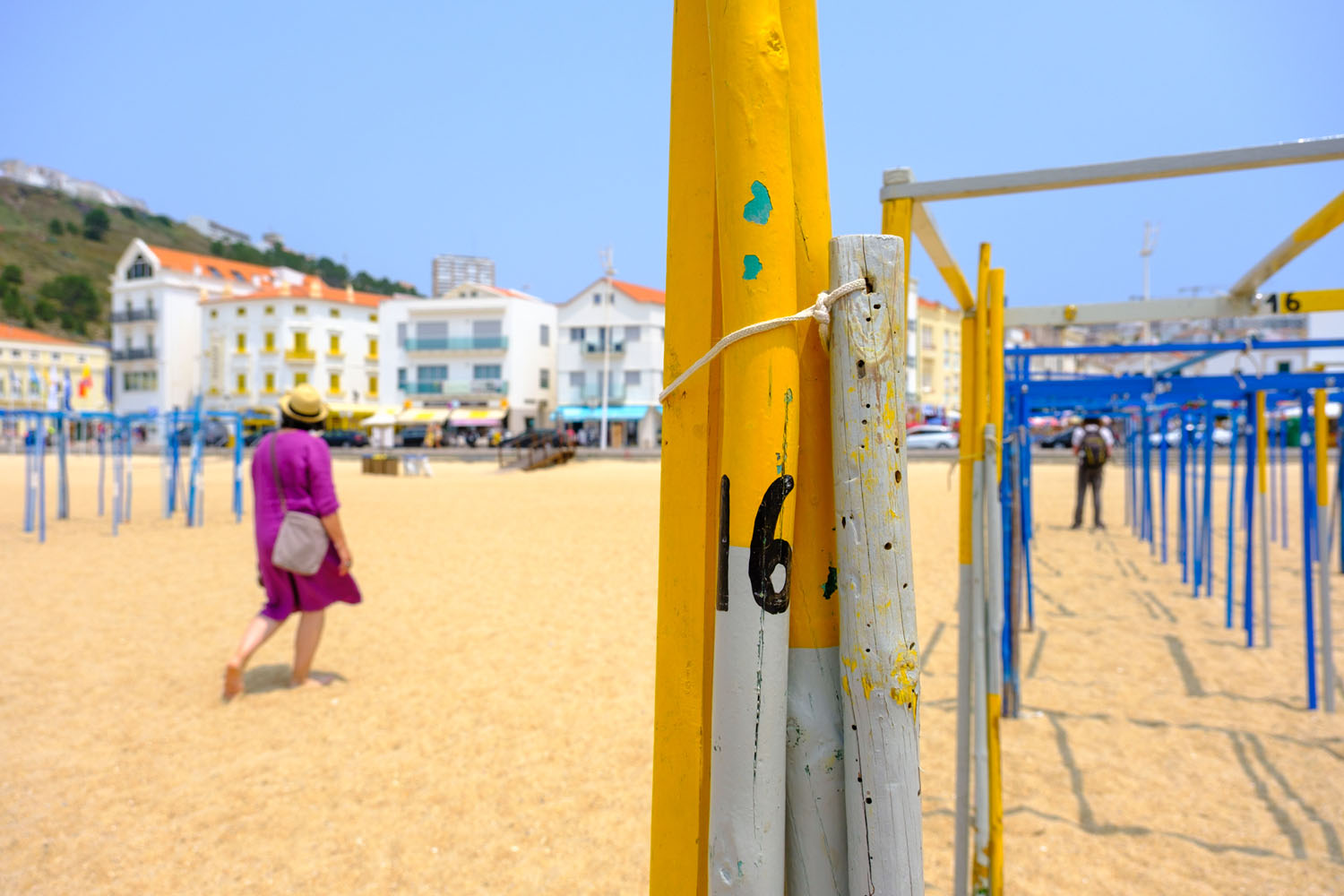
Amy on the world-famous surfing beach at Nazaré
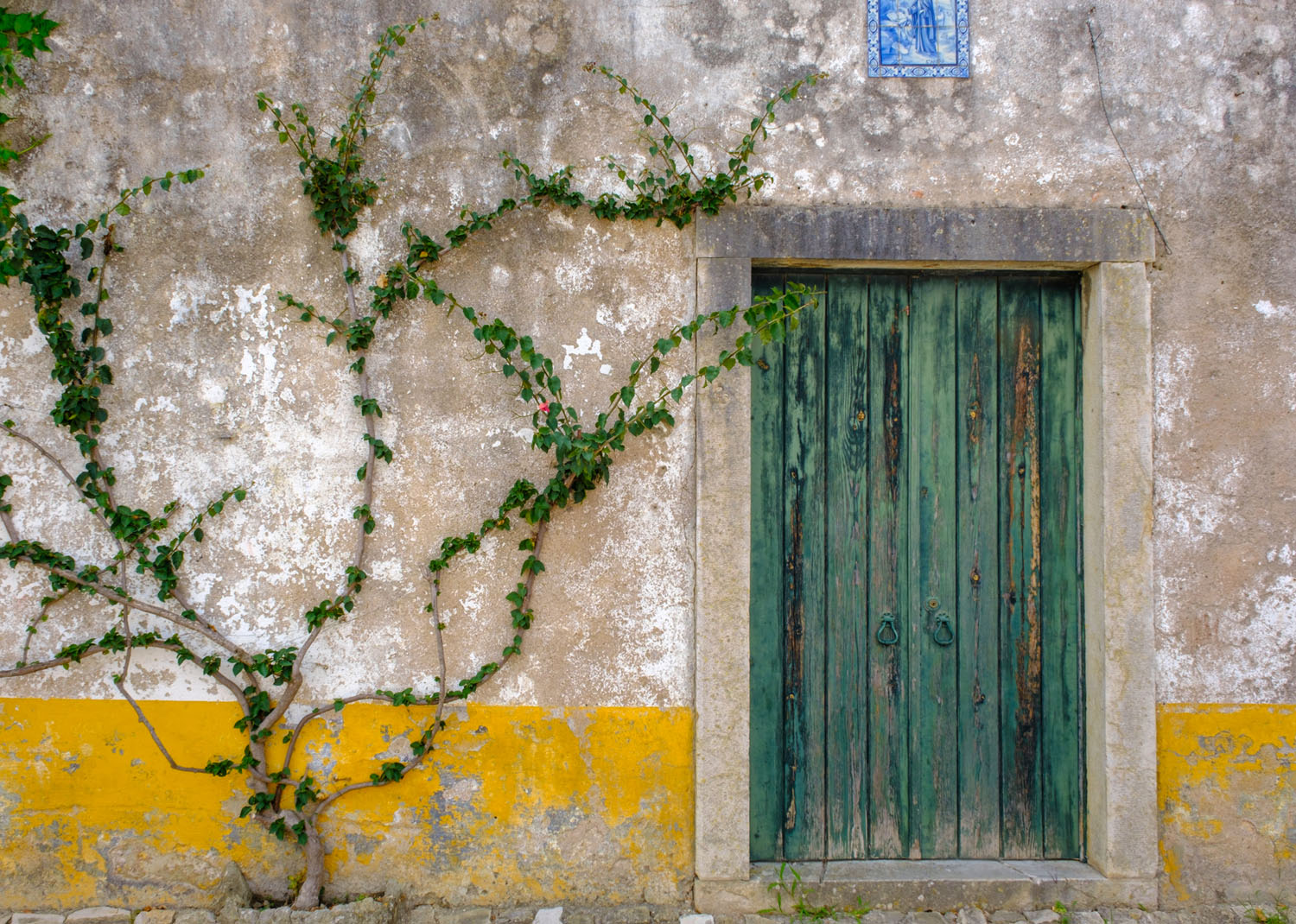
Beautiful decay in the walled city of Óbidos
Off to the Azores
It had been a life-long dream to visit the Azores, and how could we not when we were already so close? Some refer to the island chain as “The Hawaii of Europe” and I can see why – you get that beautiful blend of volcanic geography and lush tropical vegetation – but it’s all intermeshed with the funky-ness of Portuguese architecture, geothermal vents, living neighborhoods in various states of construction and decay.
Ponta Delgada
Our flight to the island of São Miguel landed us in Ponta Delgada. It’s the largest city on the largest island in the Azores, and we took a bit of time to explore before driving across the island to our home base at Furnas. Starting with a bit of beach combing, during which we found dozens of bits of old sea-washed tile, brick and mortar.

Triangle of brick and mortar, tumbled by the sea. I struggled over whether to bring this home as a souvenir, but decided to leave it where I found it.
Furnas
We settled in the funky town of Furnas, where modern design sensibilities melded with old-world Europe and geothermal geology.
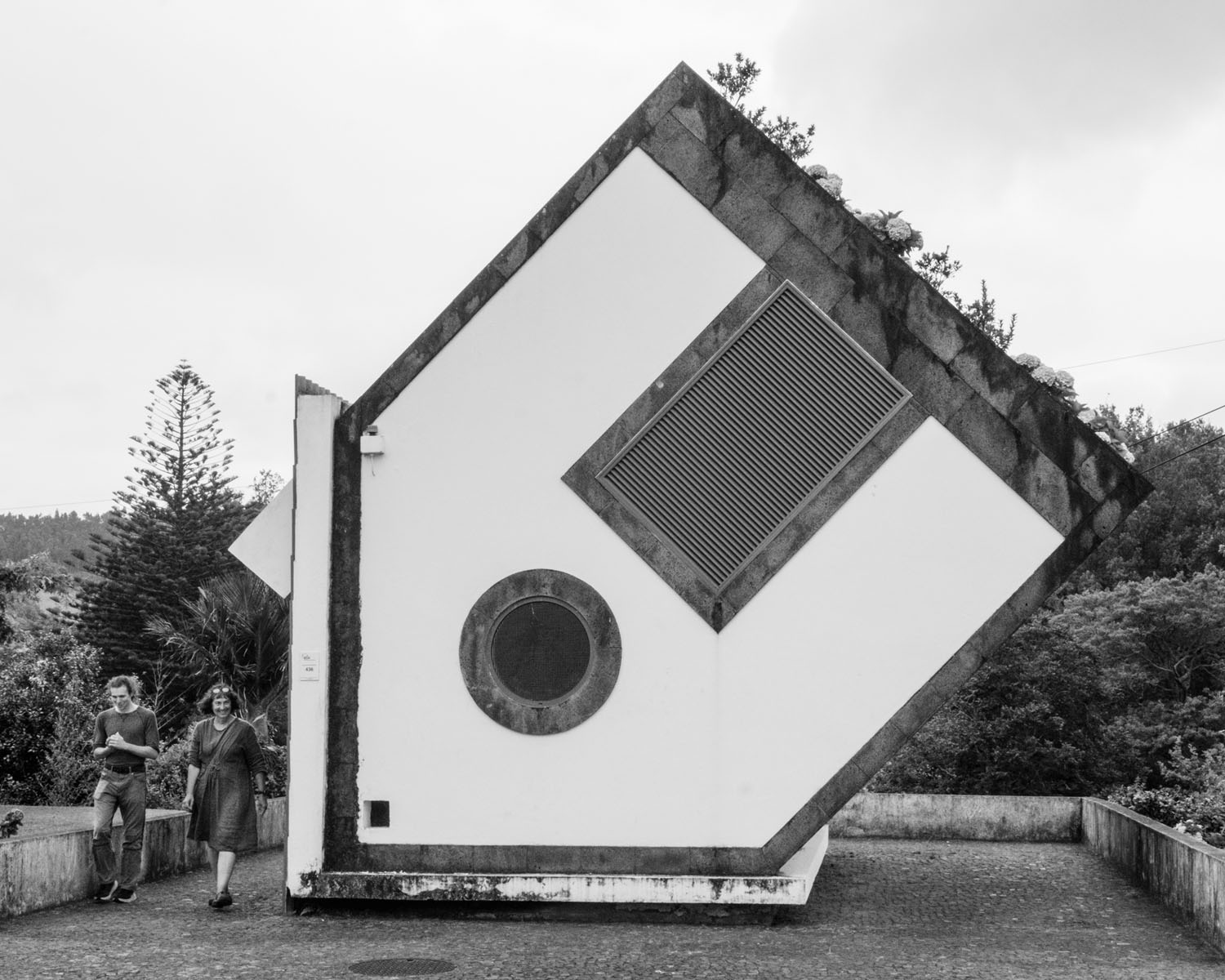
Water pumping plant in the town of Furnas, with living plants growing from its foundation (top)

Gorgeous waterfall at the end of our hike in Furnas public gardens
Grená Forest Park
As if the wonders of Porto and Lisbon weren’t enough, Portugal revealed its natural wonders to us as well. In the Azores, off to the side of Furnas’ biggest lake, we spent a day on the trails of Grená Forest Park. Magnificent flora in endless shades of green, brilliant waterfalls, verdant mosses and ground cover… a slice of paradise. I’d never seen a natural area cared for so well – trails made of crushed lava rock, bordered with wood. Wooden bridges and swings just for hikers, excellent signage, hundreds of log stairs pressed into the steeper climbs (with hand rails!). I’d love to see more natural areas in the U.S. cared for like Grená.
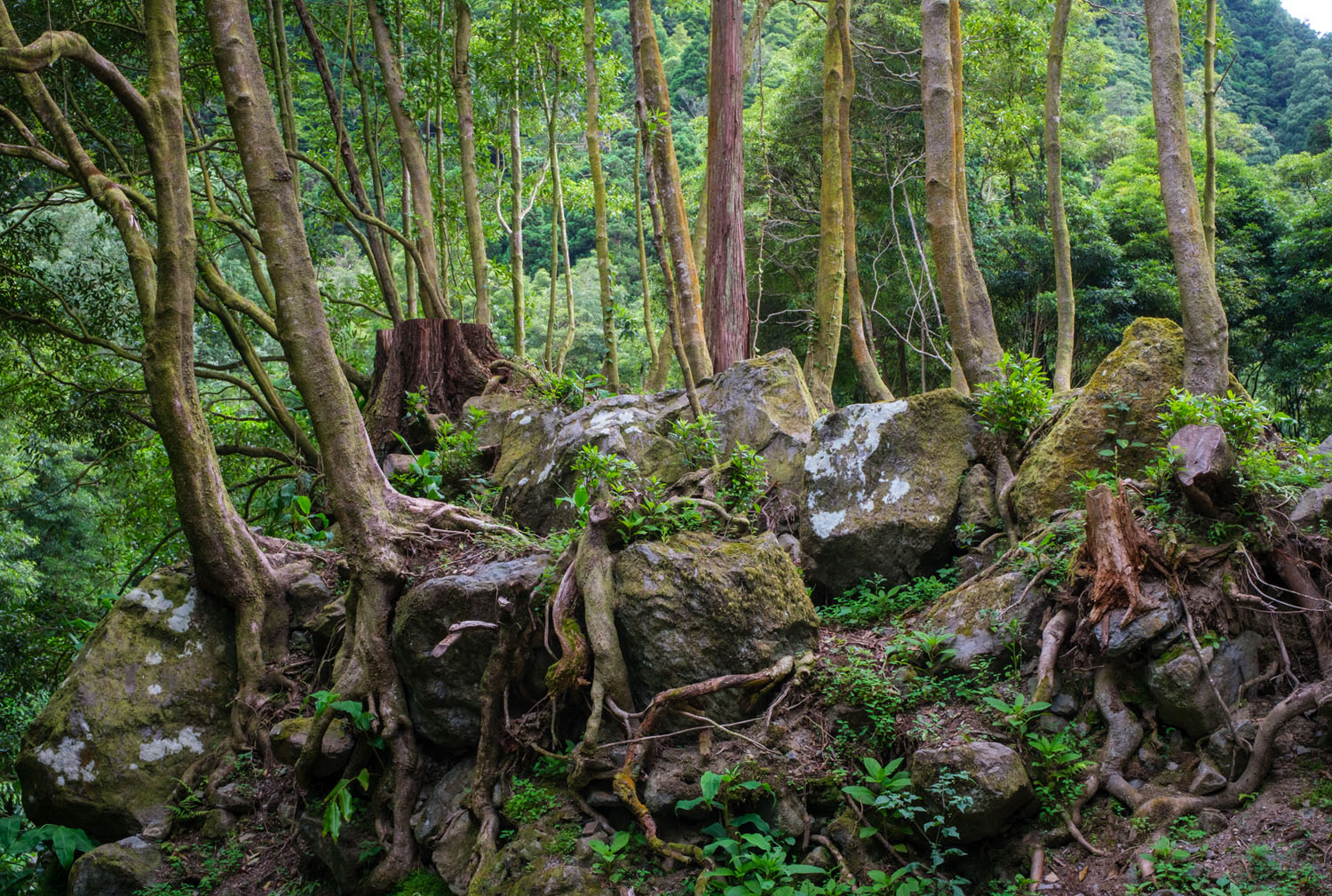
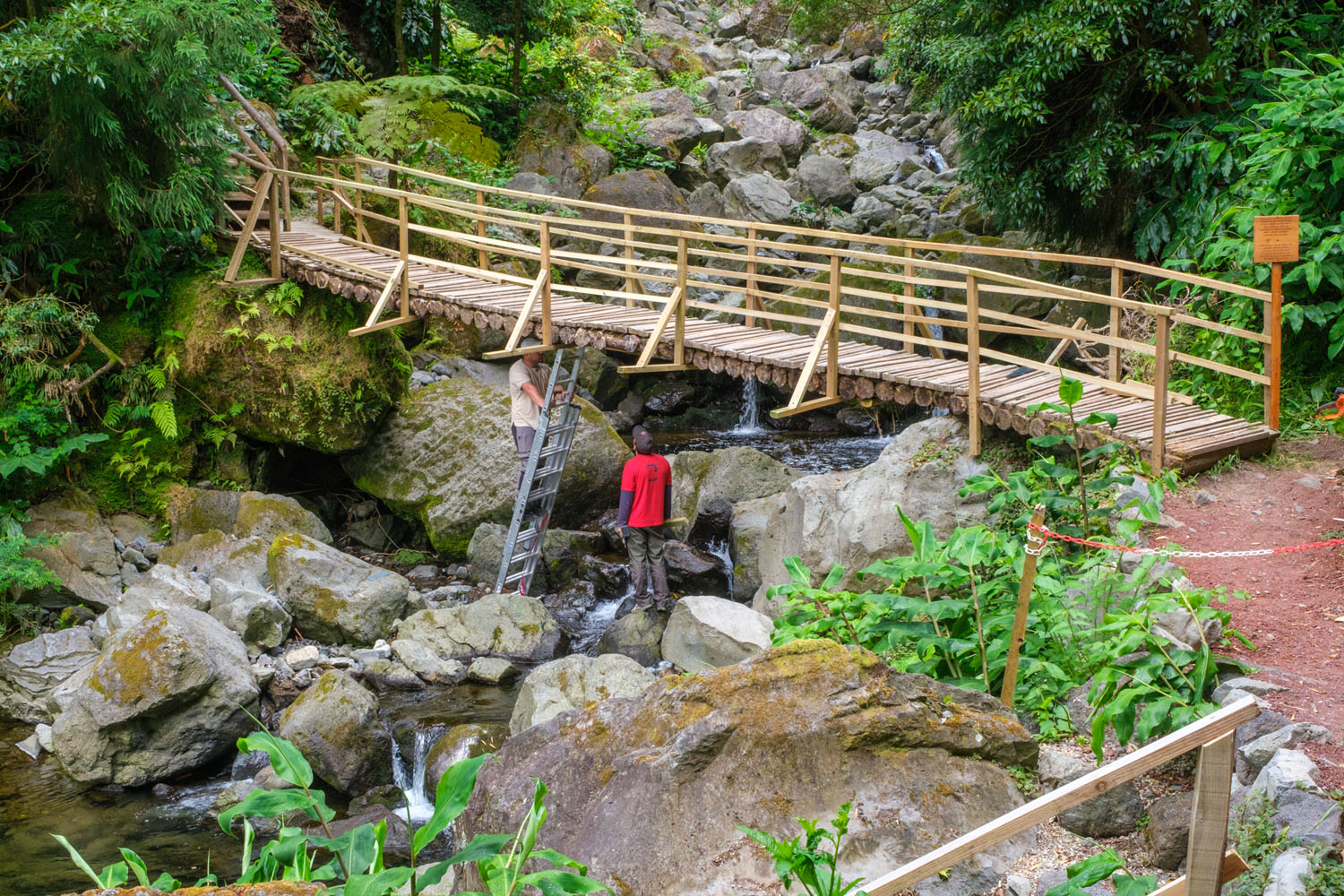
In a tangle, forest at Grená
RIGHT: Fuji X-T4 . Fuji XF30mmF2.8 Macro . f/11 . 1/125″ . ISO 640
Workmen building a footbridge, forest at Grená
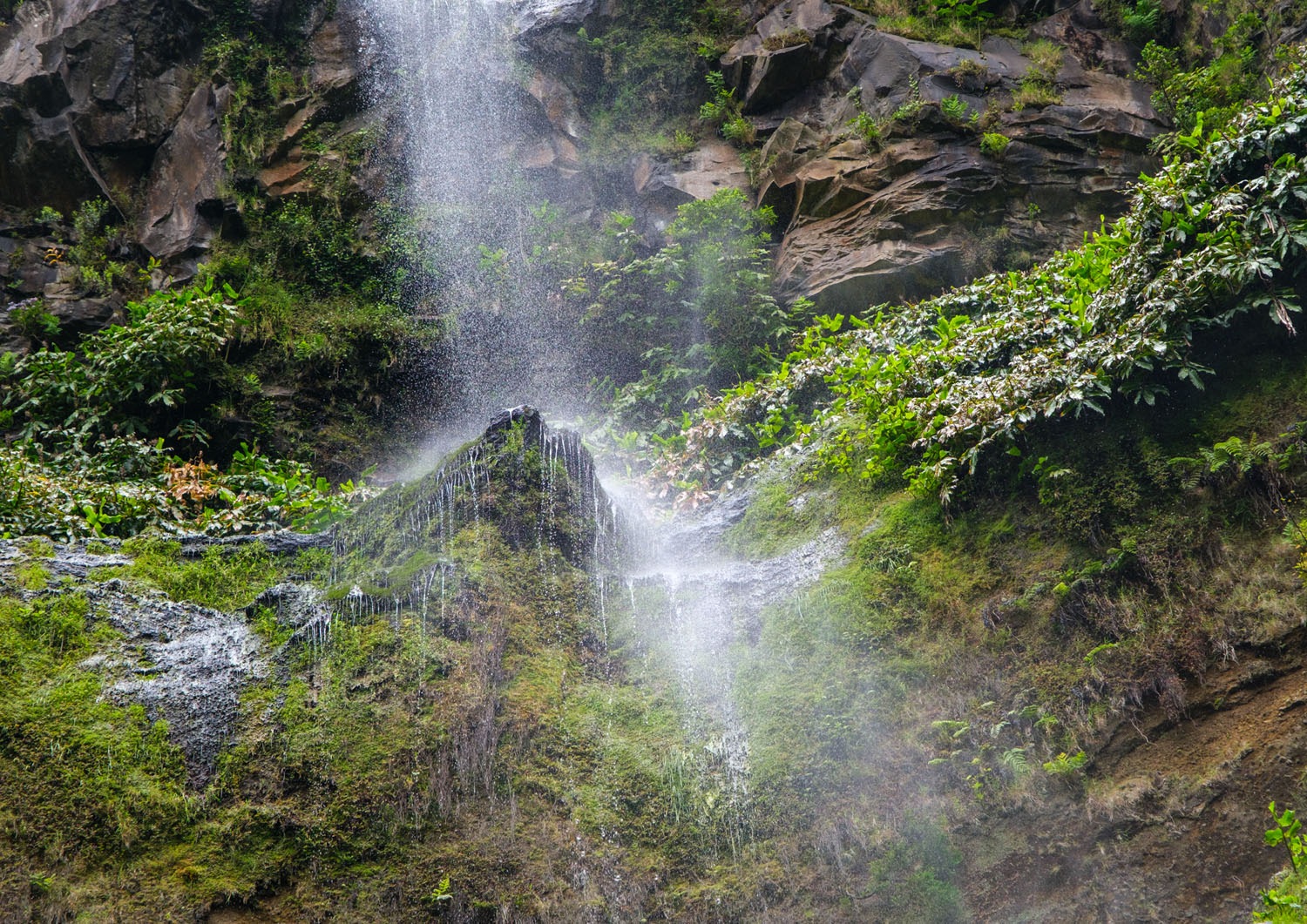
Waterfall detail, forest at Grená
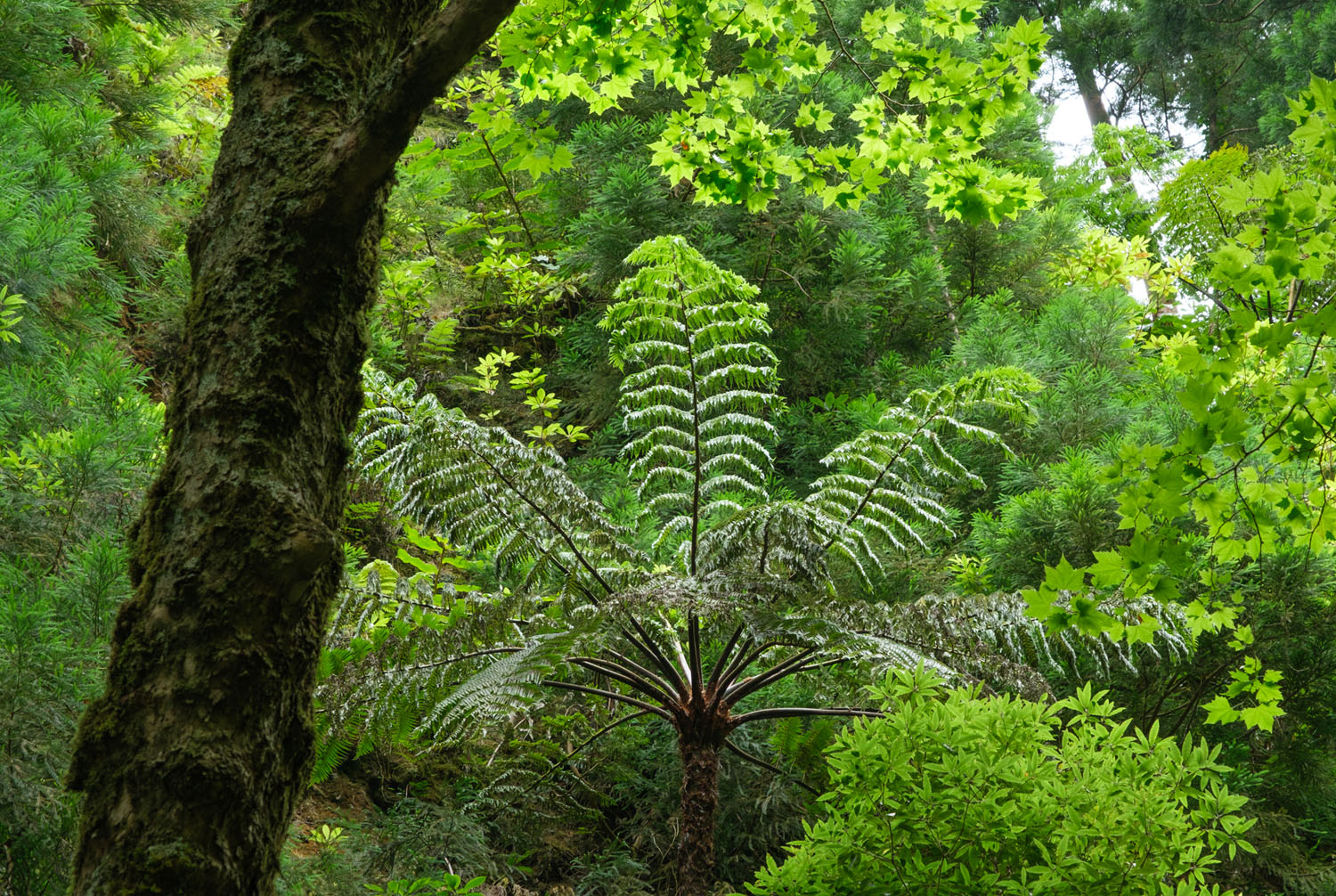
Grená forest fern
Abandoned House at Grená
In the middle of the Grená Forest Park, we suddenly found ourselves staring at this gorgeous, abandoned, moss-encrusted hotel, with large ropey roots sending tendrils down the walls. No signs telling you to keep out, no graffiti on the walls (partly because paint doesn’t stick to moss)… and no floors to separate the three stories – just rotting wooden joists. It had once been someone’s dream to create a fancy hotel in the middle of the woods, but for various reasons, the plan had never worked out, and the hotel had eventually been turned over to the park service to become part of the forest’s allure.
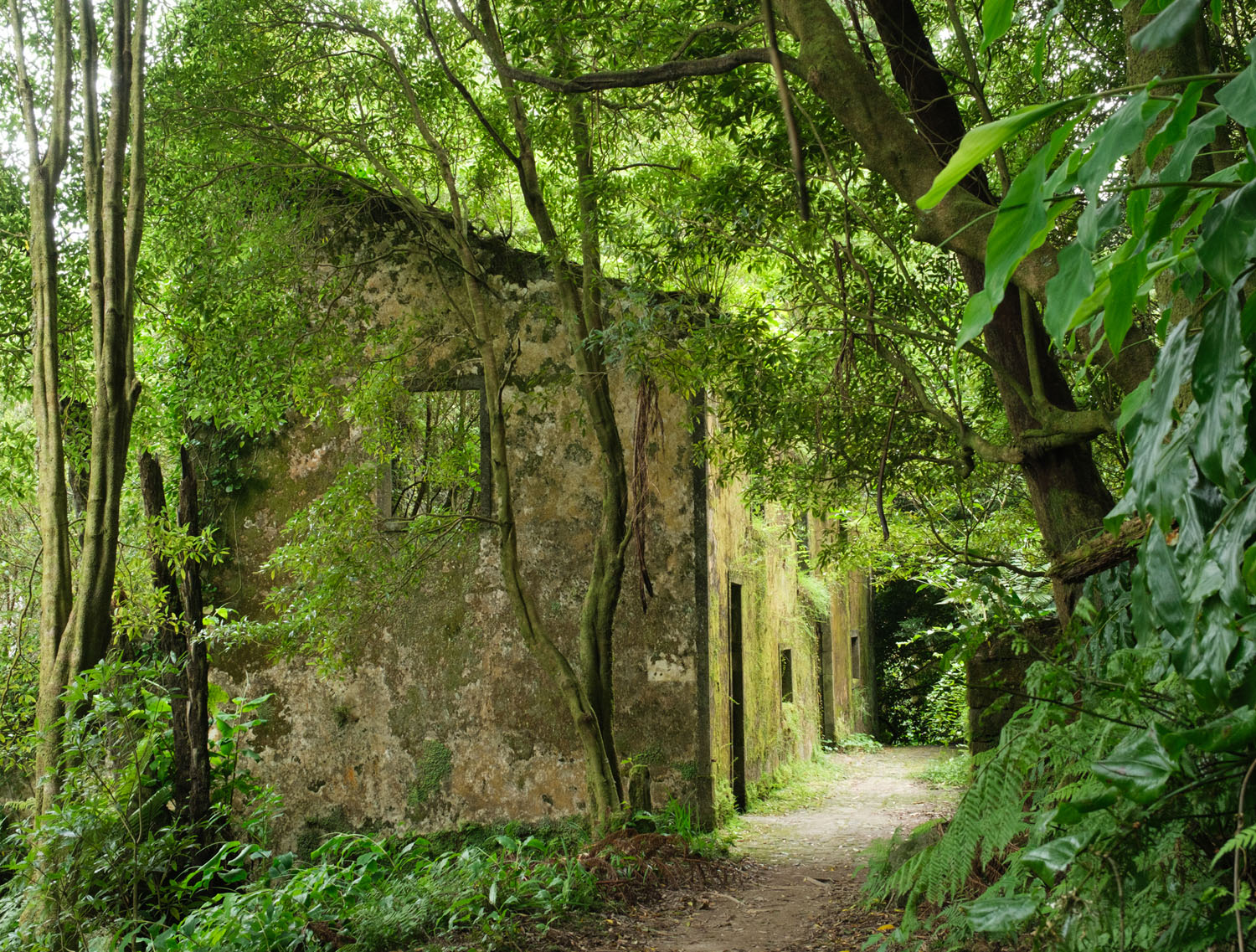
First glimpse of the abandoned hotel at Grená
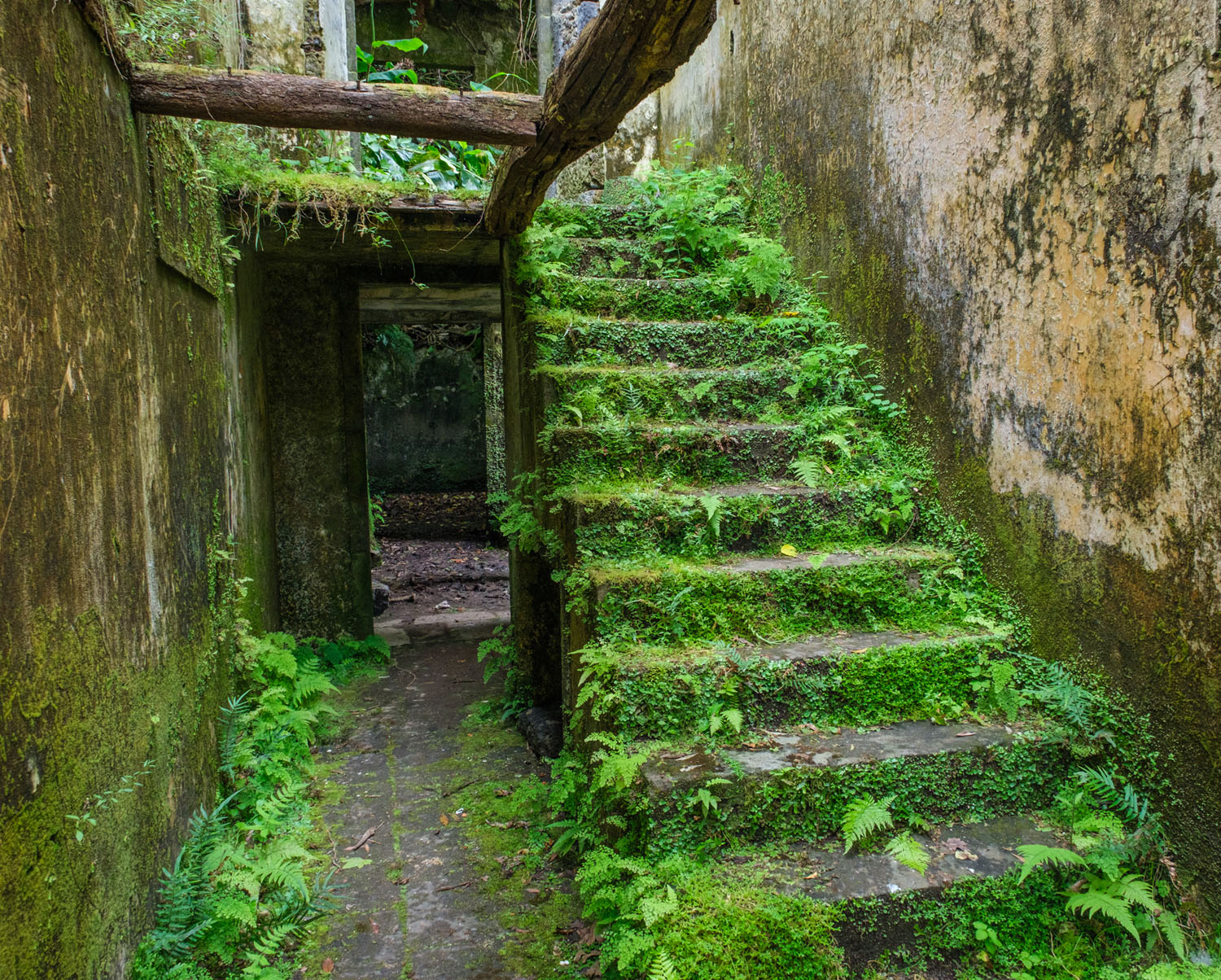

Stairs between floors that no longer exist, Grená forest hotel
RIGHT: Fuji X-T4 . Fuji XF16-80mmF4 @16mm . f/4.5 . 1/60″ . ISO 1600
Roots and vines embroider the walls in the hotel at Grená
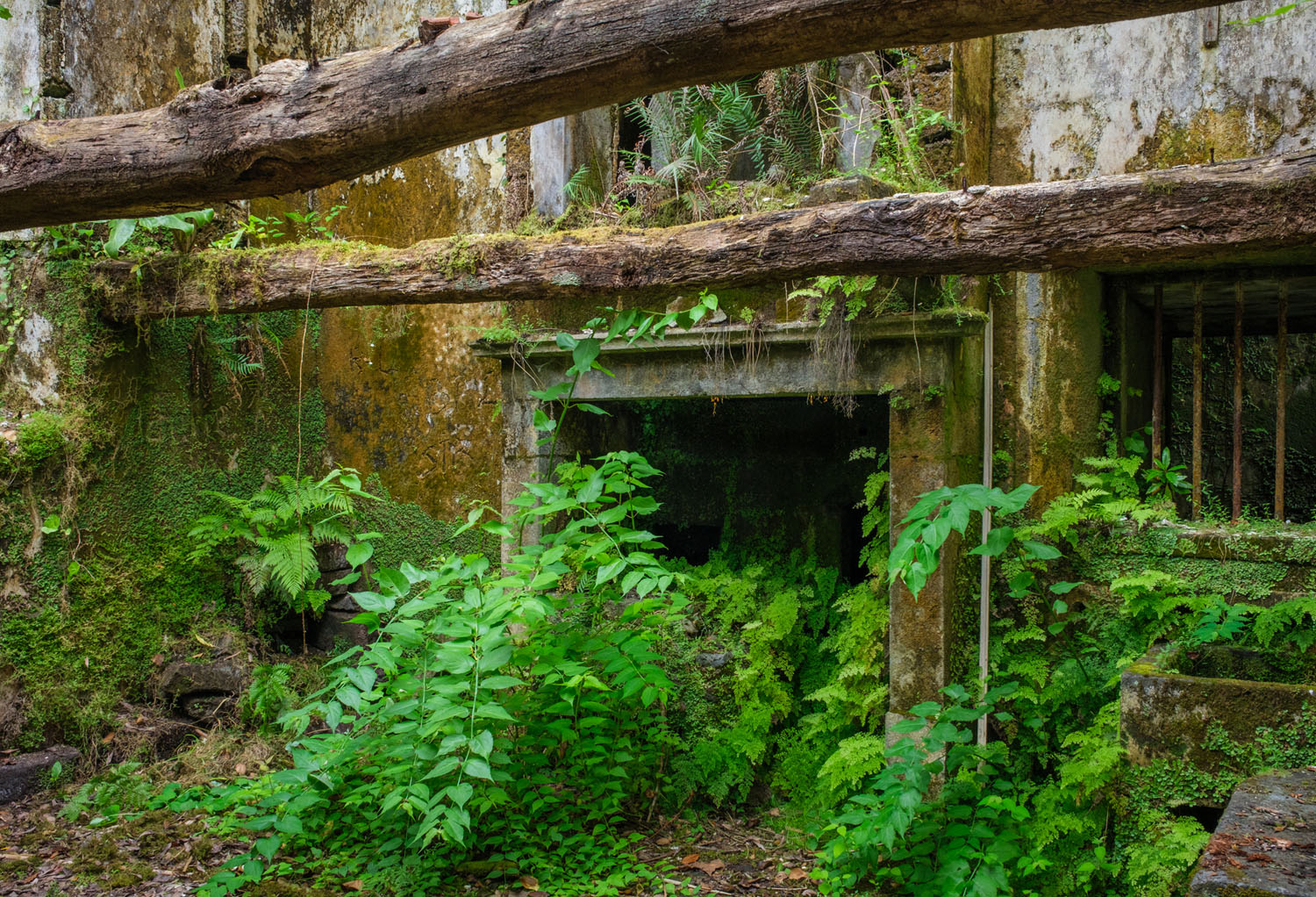
Antique hearth in the hotel at Grená
Geothermal baths
Thermal hot springs run through several parts of the island of São Miguel in the Azores, and we often saw steam venting up from the ground. As is common in Iceland, locals gather to enjoy geothermal baths in the evening.
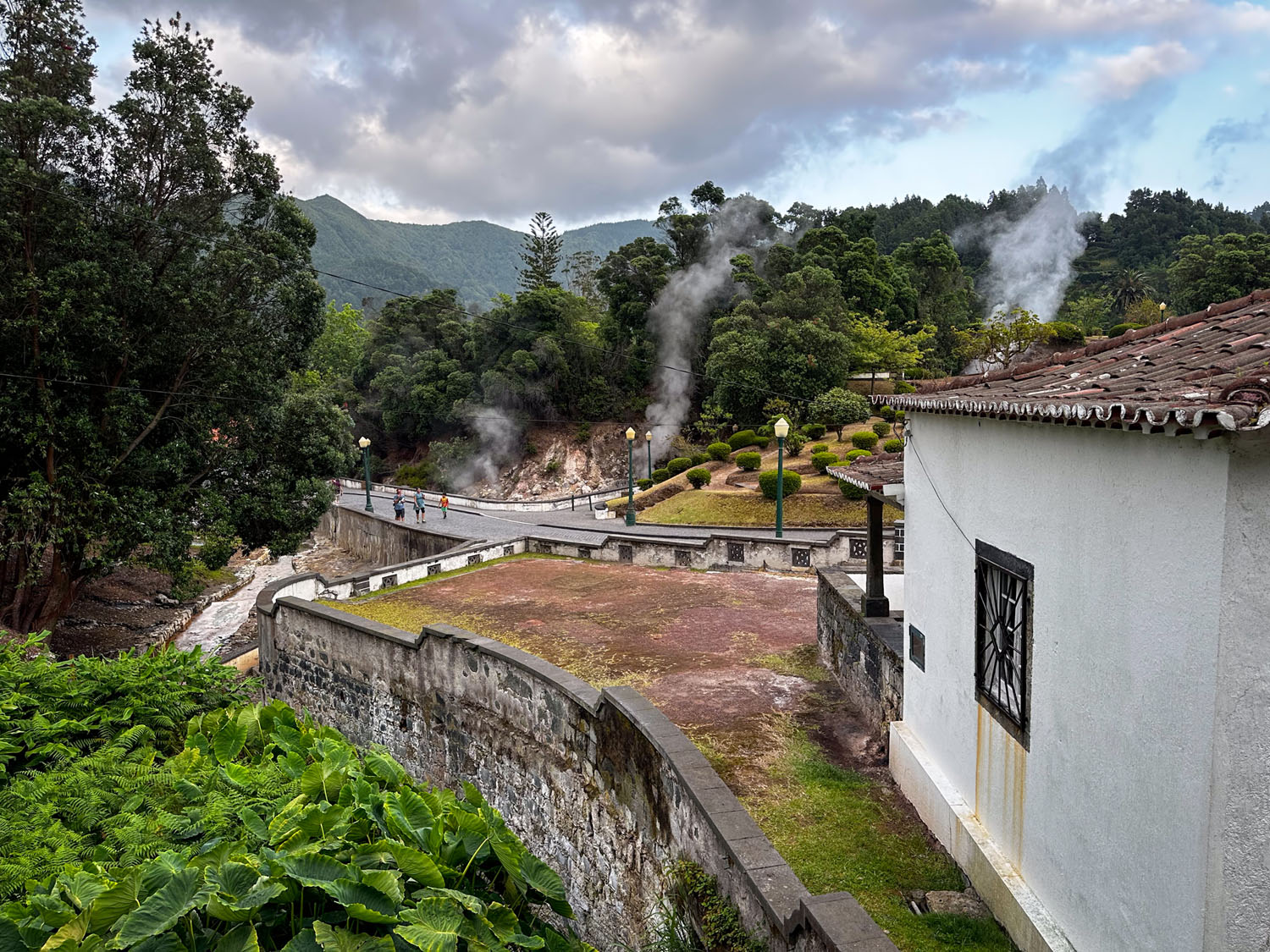
Neighborhood on the edge of Furnas, peppered with natural steam vents.

Naturally heated creek running through the geothermal baths at Furnas
Sete Cidades
Literally “Seven Cities,” Azores’ Sete Cidades is named for a bit of murky history about seven communities having existed near a three-mile wide volcanic crater around 750 A.D. There’s no solid trace of the communities, but the craters are most definitely still here. The crater contains two lakes – one green and one blue, due to a difference in algal populations. Unfortunately the difference only appears dramatically under the right light conditions. We were treated to a spectacular display of the green lake, but didn’t catch much blue. The contours, and the wild hydrangea-lined highways that run between the lakes, are unique and beautiful.

The impossible greens of Sete Cidades
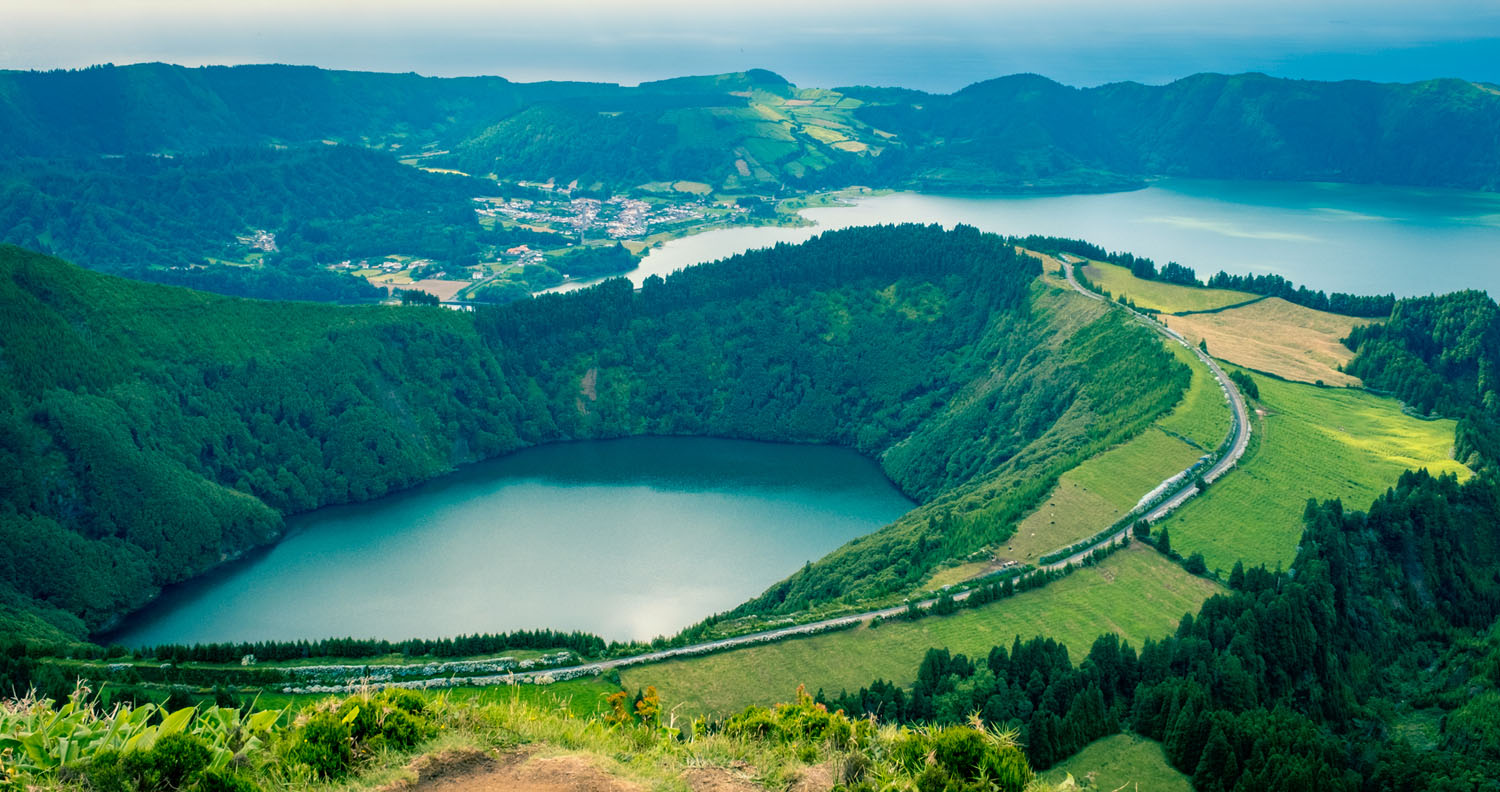
The twin lakes of Sete Cidades, one green and one blue
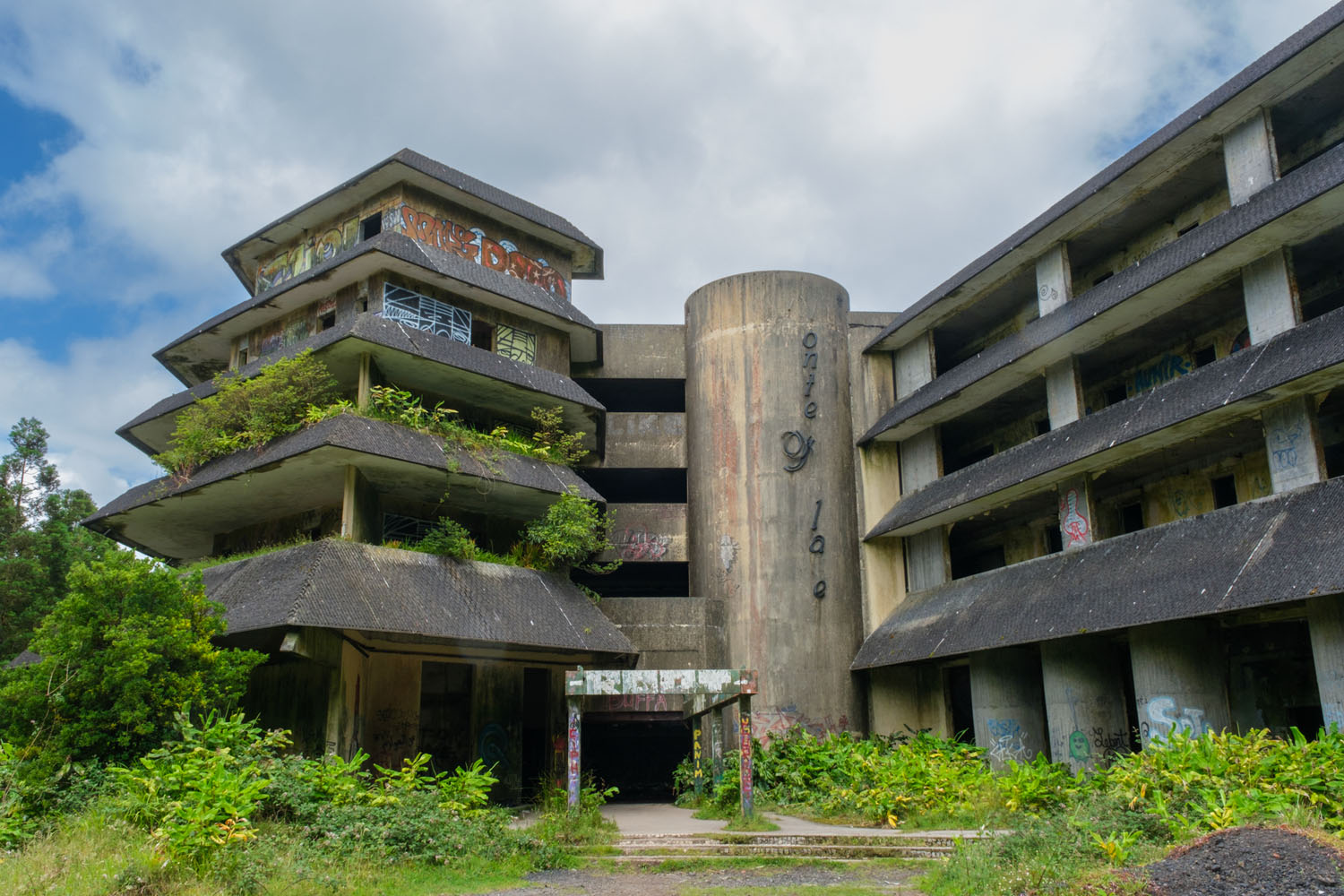
A developer once built a hotel near the rim of Sete Cidades, only to run out of money before it was done. Visitors to the monument can do a bit of “urban exploration“ after checking out the views.
Hiking the Lagoas
We had heard there was some excellent hiking near Sete Cidades and set out to find some of the trails in the area. Steep ravines, deep greens, “Lagoas” (lagoons) at the bottom of craters, hills with their tops inexplicably chopped off, fascinating contours enhanced by hedgerows, and all of it punctuated by patches of bare lava rock. The area felt like a fusion of Iceland and Kauai.
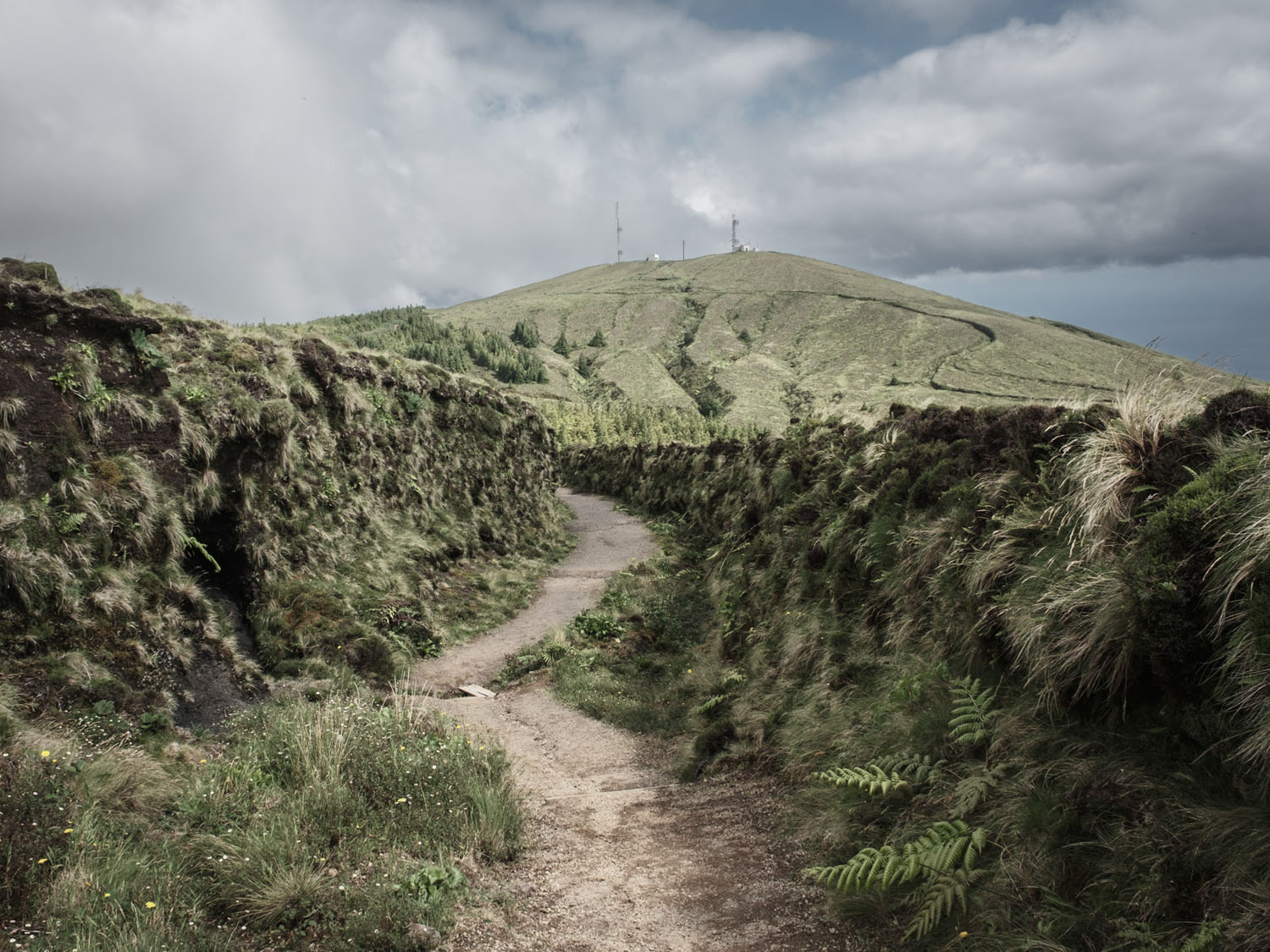
Volcanic mini-canyon becomes part of the trail through the lagoas. I’ve discovered that the Fujifilm Bleach Bypass profile is fantastic for taming brightly lit nature scenes without resorting to black-and-white, and I lean on it quite a bit for those conditions.
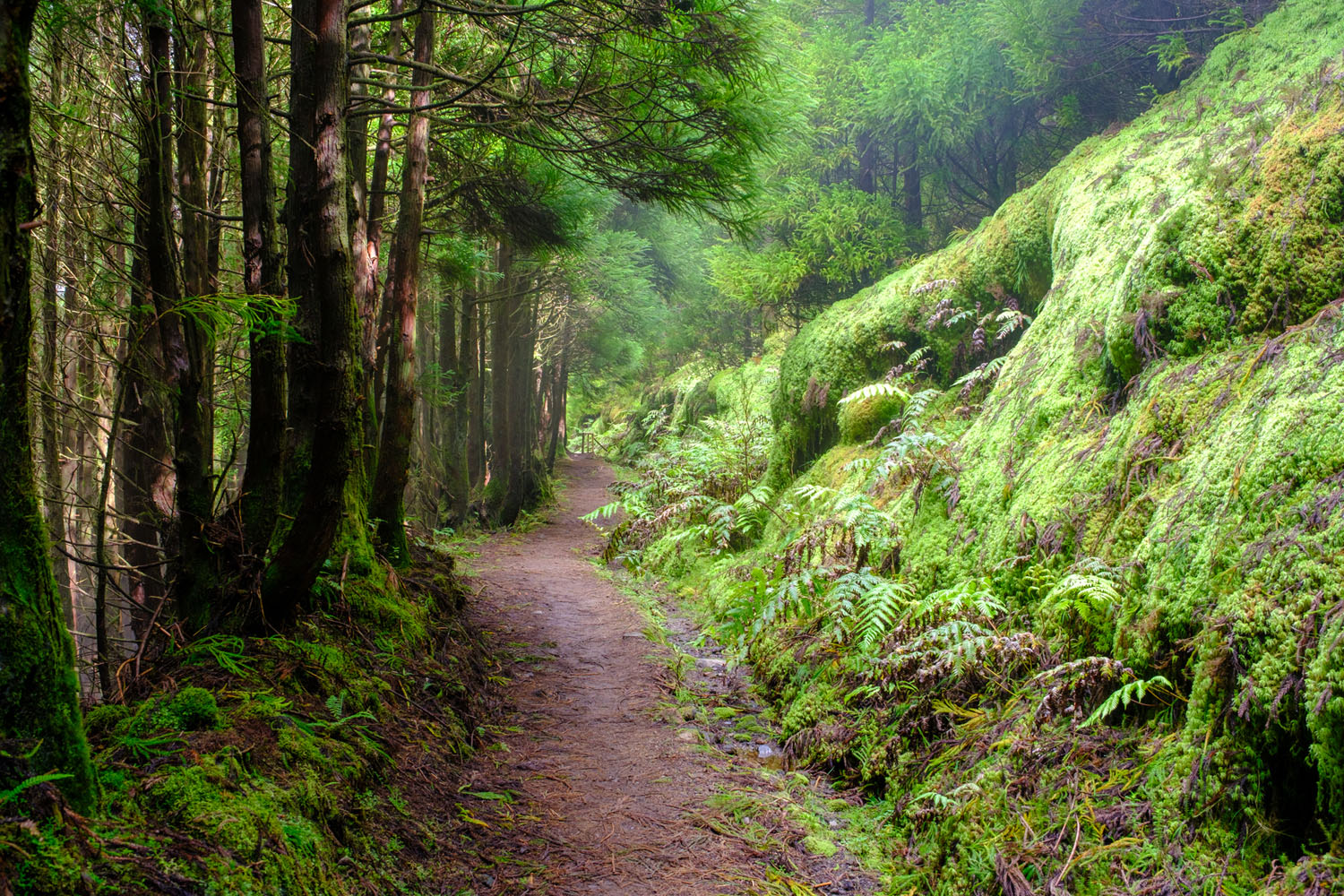
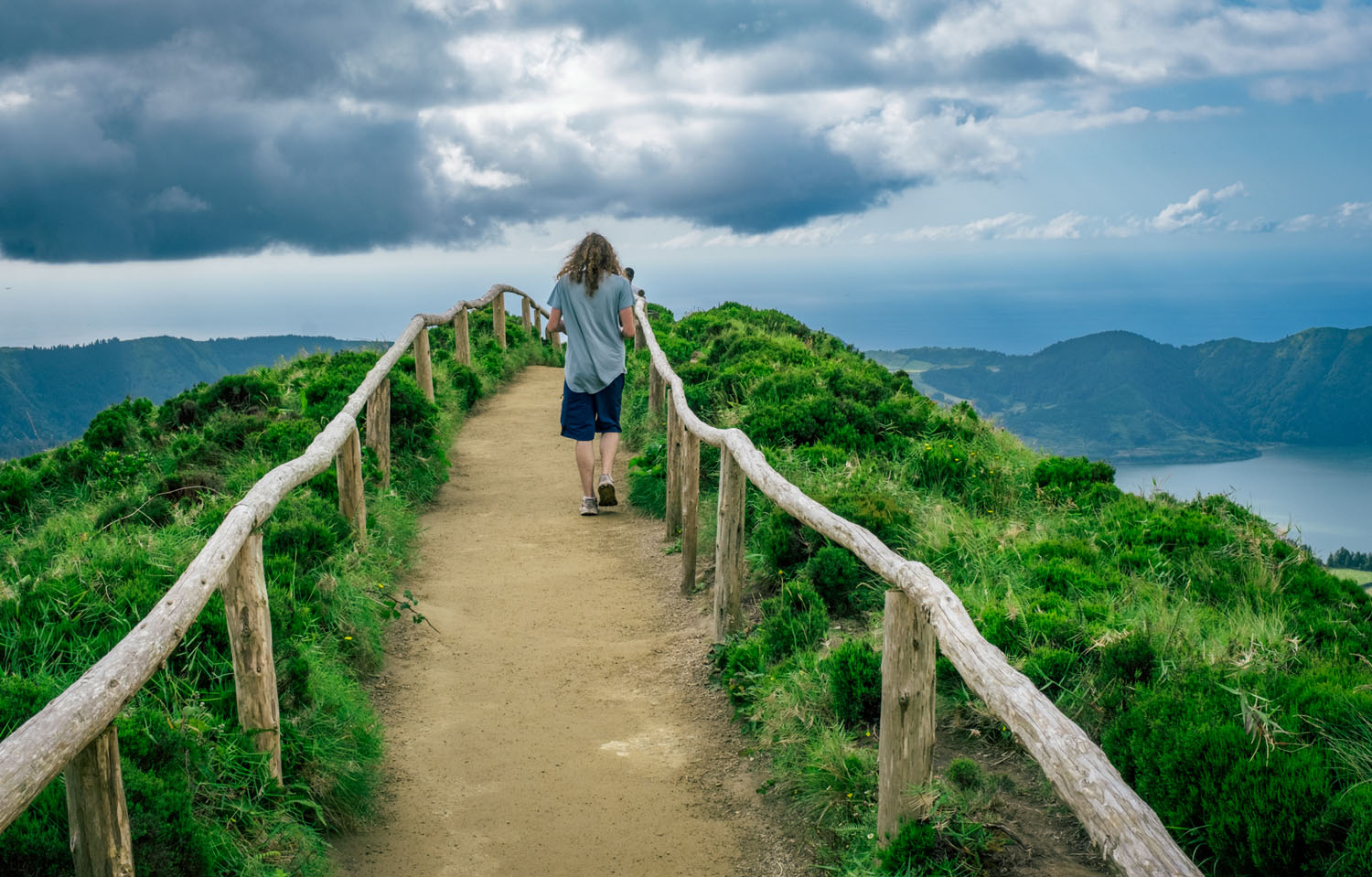
After a few miles of trekking through the lagoas, we finally made our way back to the road
RIGHT: Fuji X-T4 . Fuji XF16-80mmF4 @27.50mm . f/14 . 1/250″ . ISO 500
Miles on the edge of Sete Cidades
Lisbon and Porto
Every where you turn in Portugal, there’s another photogenic scene, which kept me happily occupied. Here are some miscellaneous street scenes from downtown Lisbon and Porto.

At the Lisbon flea market, I went “stealth” and shot from the hip with the compact 23mm prime. I was fascinated by these older Portuguese women bantering while the flea market went on around them.
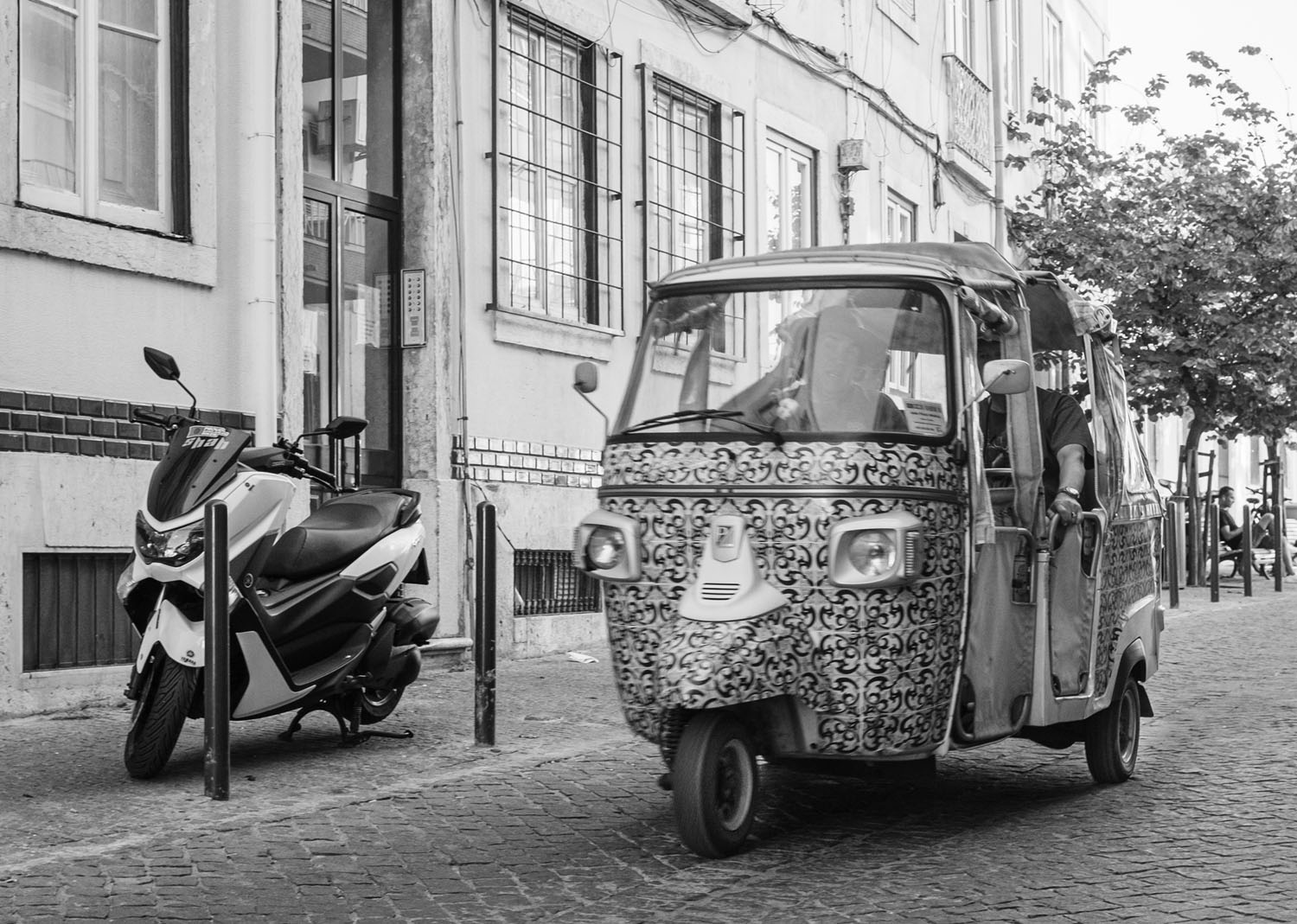
Lisbon tuk-tuk with scooter
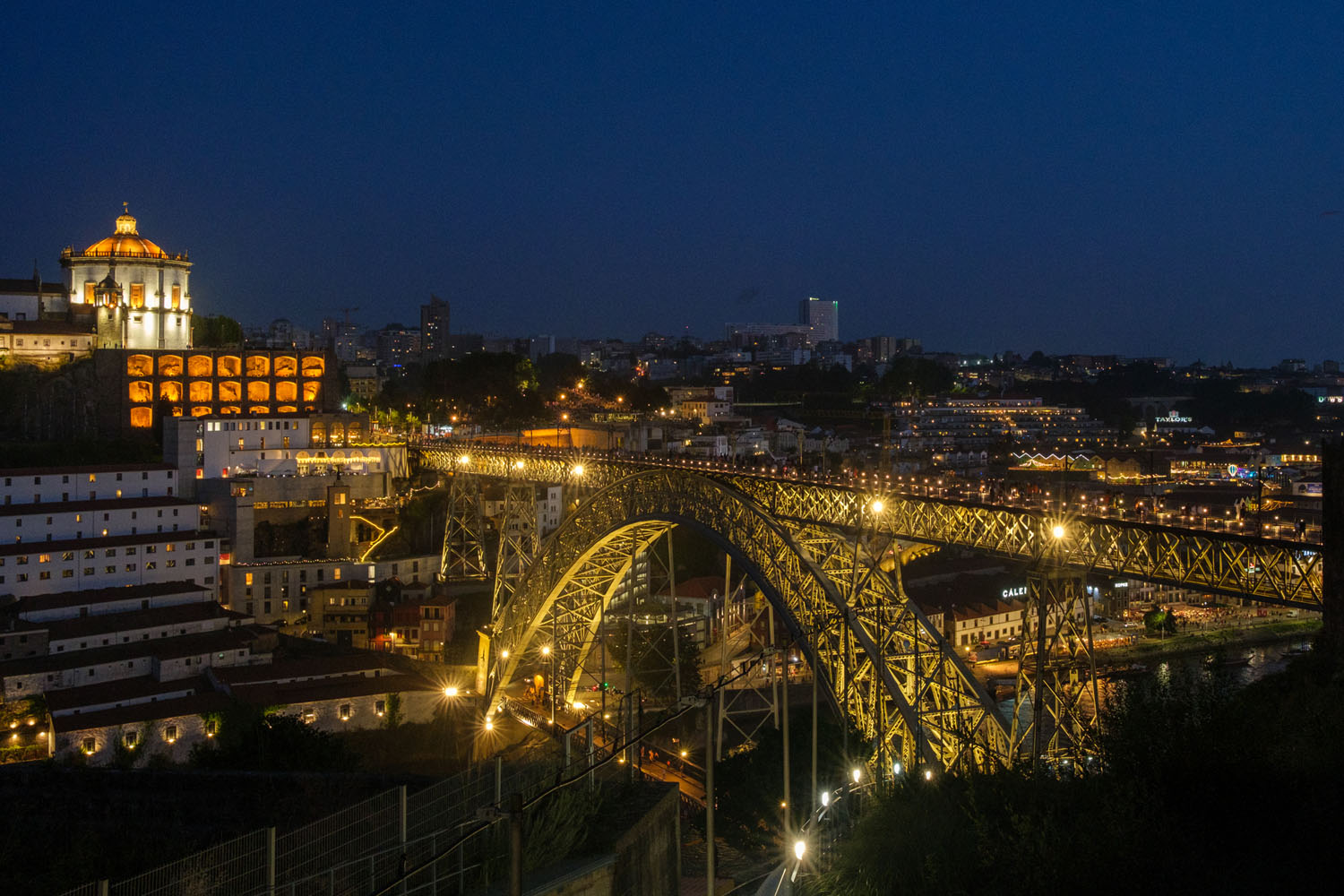
Don Luis Bridge, Porto at night
In Post
For me, the practice of photography is like a tripod, where the three legs are:
● Being there: Where did you go, and what did you experience?
● The act of shooting: What compositions did you find or make, what decisions did you make in-camera?
● Editing: What did you discard and what did you keep? How do you edit and present what you kept?

Woman in mourning, Lisbon cemetery
I only shoot RAW, and start every edit by choosing either a Fuji film simulation or a third-party profile. Sure, if I was shooting slowly, I could choose the just-right sim in camera while shooting, but usually I’m moving quickly through the world, with family, and just can’t take all the time I’d like. So I usually leave the camera in Provia mode and then try out various profiles in post. There are exceptions – there was a period when I left the old-school 23mm prime on the camera and shot 48 hours of Lisbon in nothing but Acros. I love that I can shoot in black and white and switch to color later, but I ended up keeping most of those in Acros b/w.
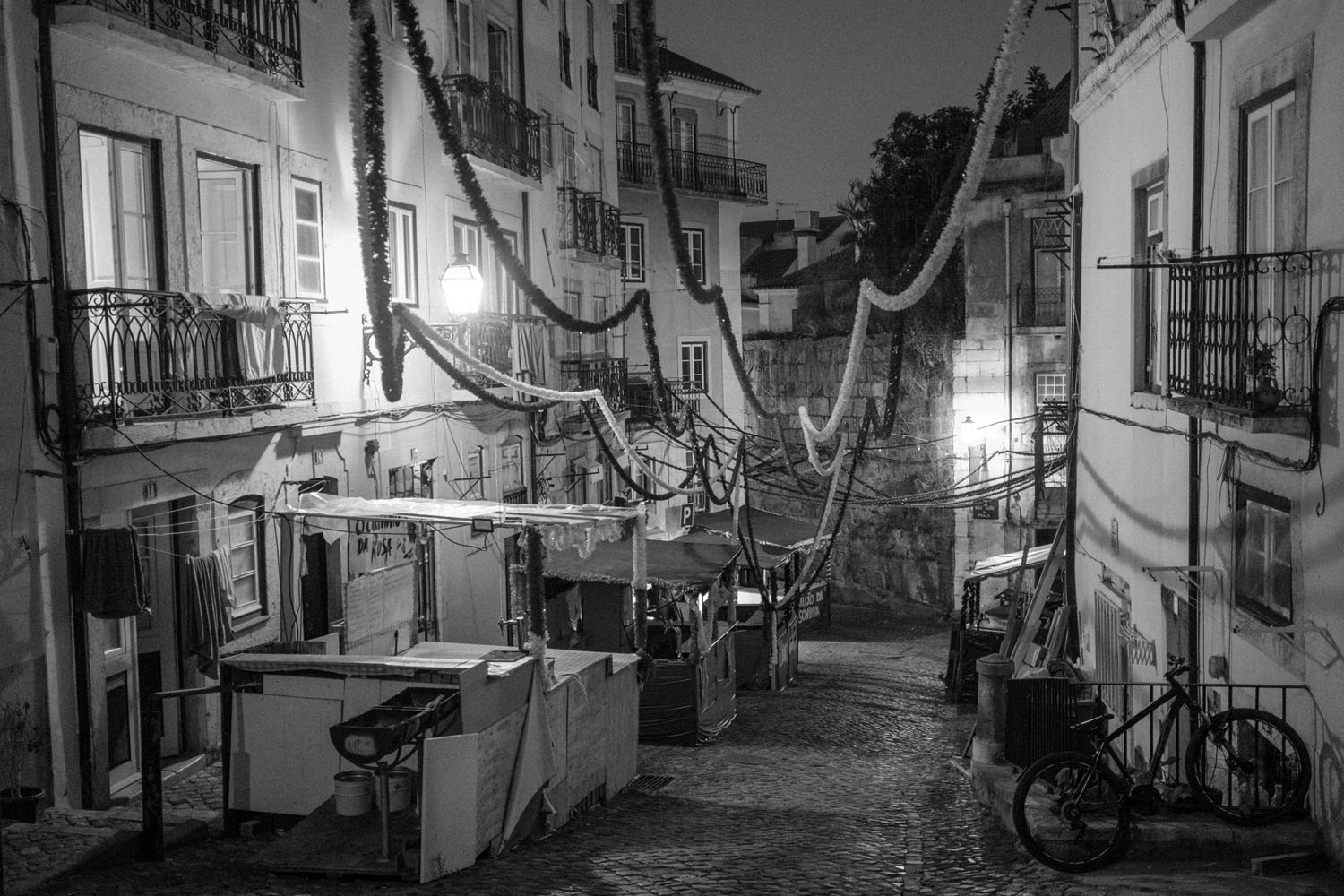
Alfama after the festival
Once I’ve decided on a Profile, I usually do the usual “bring up the shadows, bring down the highlights” thing, then continue to tweak manually. Occasionally I wander out of the Fujifilm sims and play with some of the third-party profiles I’ve purchased over the past few years, like the MattK set, or the Kelvin Design profiles (I love profiles and rarely use presets). I almost always finish by adding a touch of vignette, which has an almost-magical way of focusing the viewer’s eye.
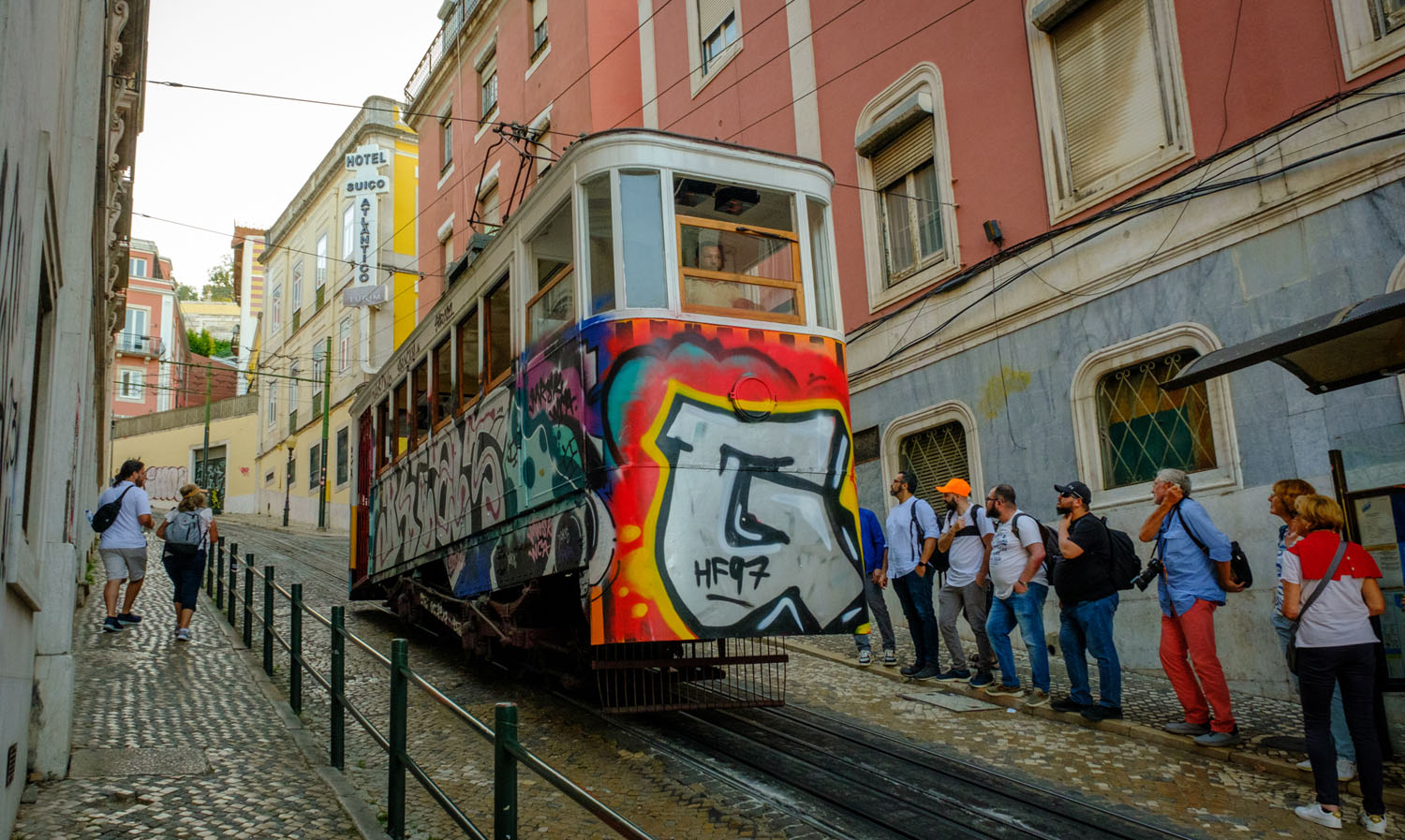
The Lisbon funiculars keep riders on a level platform as they ascend and descend the steep streets. I waited around for this one, thinking a “train” would come soon, and was rewarded when it did.
It’s important to me not to alter reality in a deceptive way, and I struggle internally over little decisions that people seem to take for granted, like twig removal. I do take some liberties, but try not to make significant alterations that could be considered deceptive. If I apply more dramatic effects, I do so strongly, so that it’s clear you’re looking at a treatment, not reality.
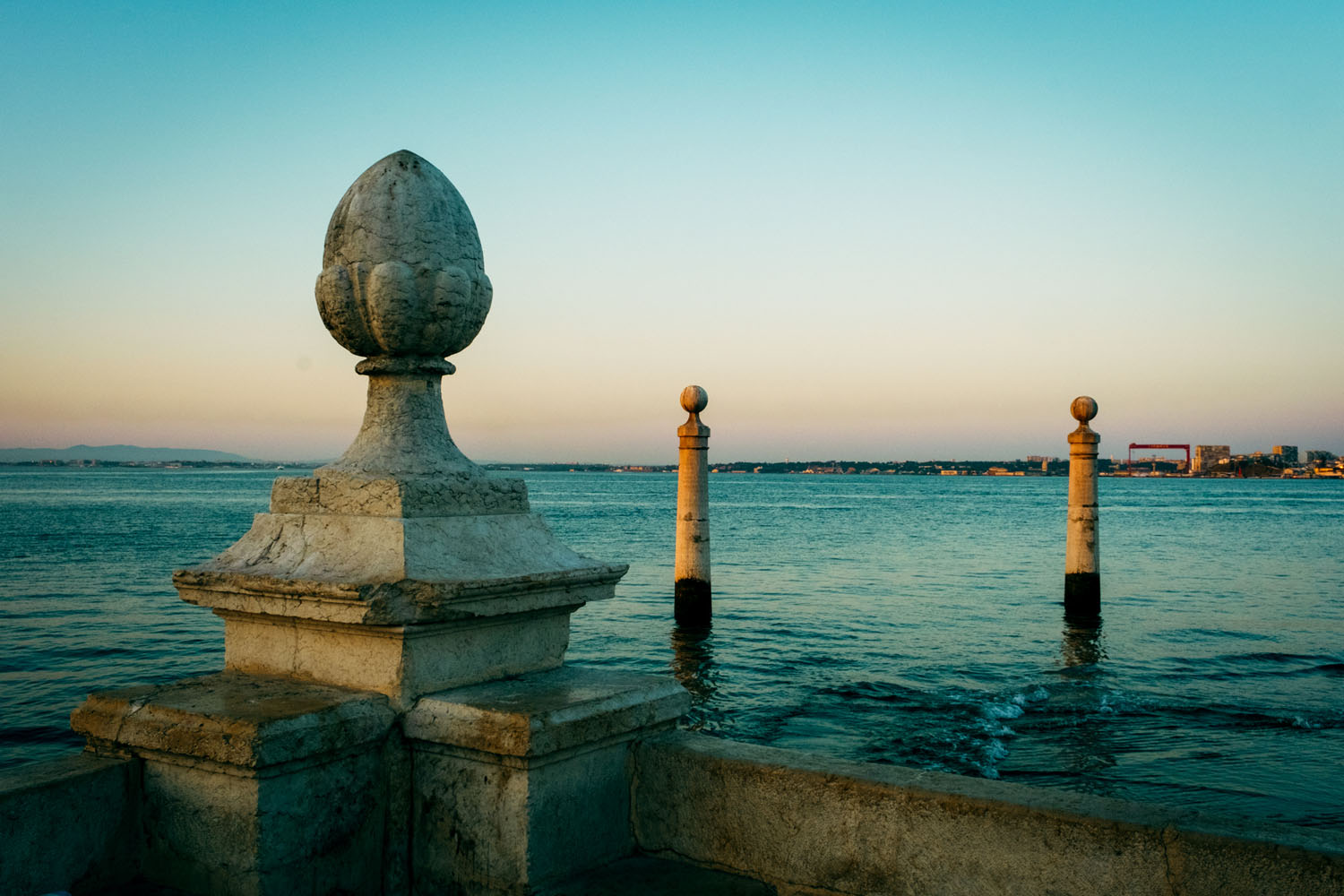
Lisbon waterfront, sporting architectural remainders of a bygone era
Online
I have a daily ritual of posting twice daily to a handful of services: Flickr, Instagram, Vero, Glass, Mastodon, Threads, and Facebook. It sounds like a lot of work, but I’ve got it down to a pretty smooth flow from the iPad, and it only takes about 10 minutes for each session. I even made a little video to illustrate the LR Mobile + iPad posting workflow I’ve developed. The harder part is staying in touch with my contacts on those services, but honestly, I only really pay active attention to Flickr and Glass – Flickr because it’s the OG, and still the best feature-wise (how is that no other service has an API, or topical groups with discussion forums is beyond me). Flickr is showing a few age-related warts which they seem slow to fix, but I cut it a lot of slack because I get far far more traffic on Flickr than anywhere else, and because I love it like a brother. I wrote an article on the vibrancy of Flickr for Medium a while back: Flickr Is No Ghost Town.
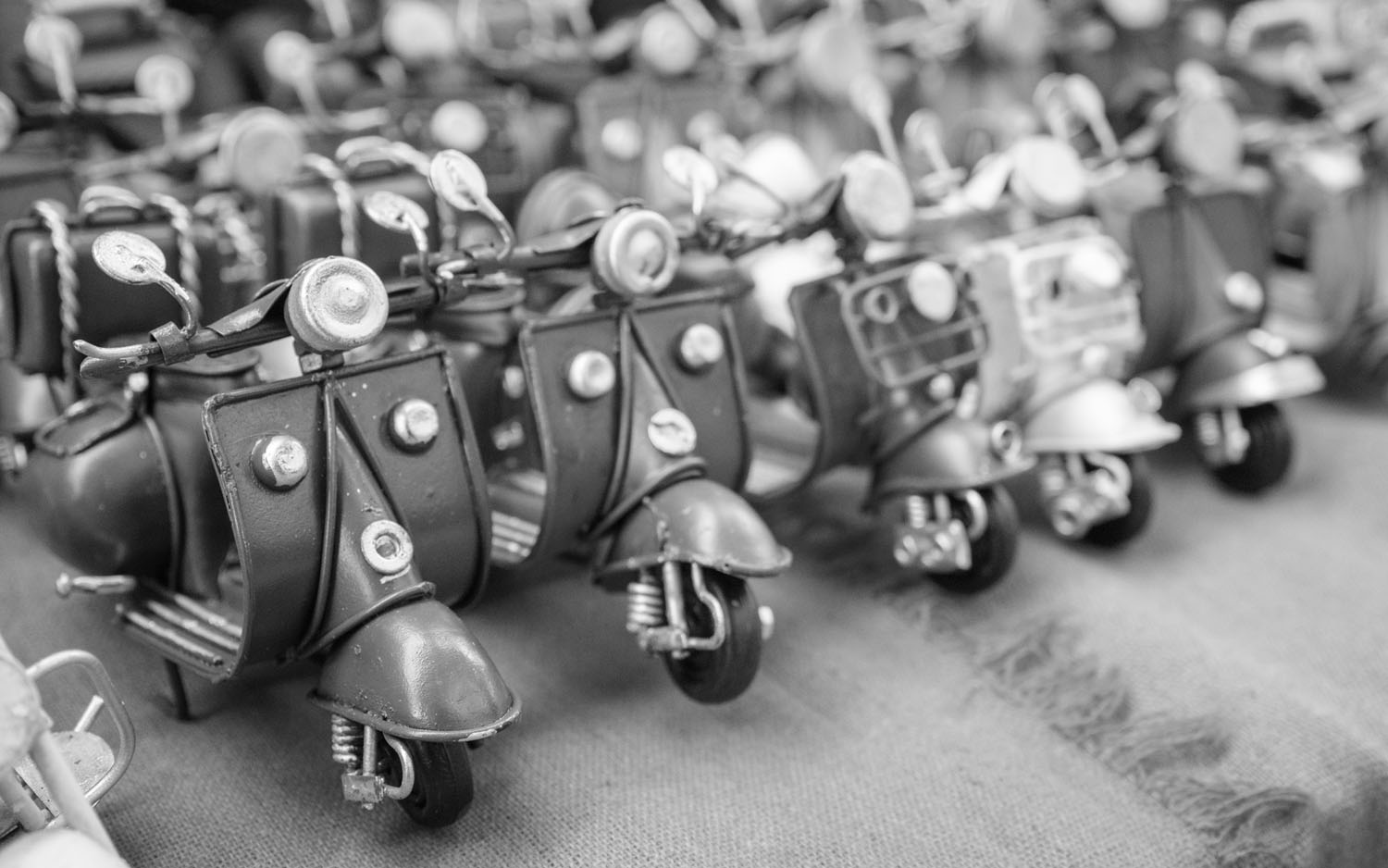
Miniature Vespas made by a street vendor near the castle at Sintra
On the flipside, I’ve really been loving Glass over the past year. Not only does it attract a lot of Fujifilm and Leica shooters (kind of crazy Fuji proportions, actually), and there are some really talented photographers there, but the company is making conscious UI decisions to reduce or eliminate the toxic habits of chasing likes and obsessing over numbers. And their web UI is as good as their mobile app.
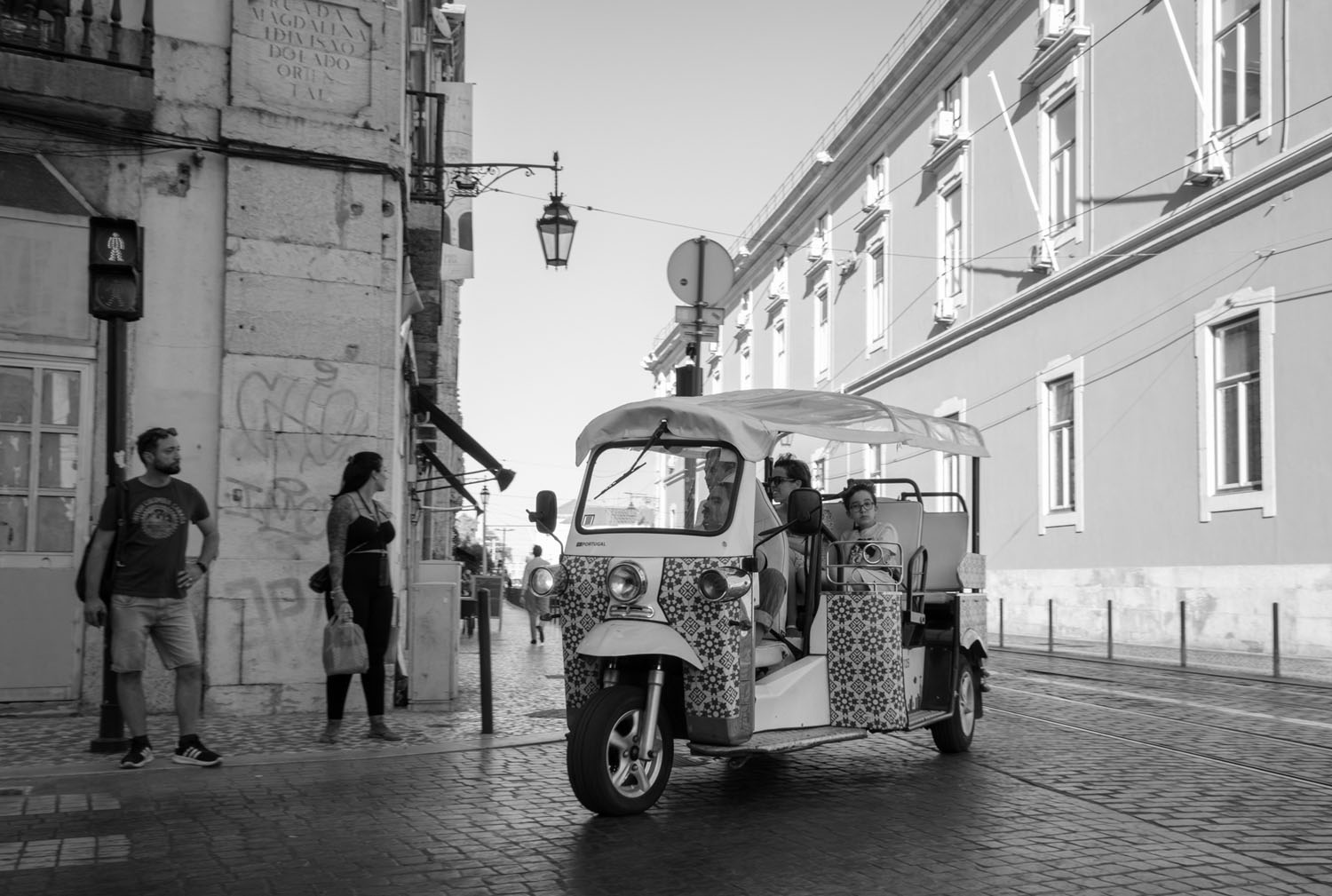
Lisbon tuk-tuk
Flickr and Glass are paid platforms, but both are algorithm – and ad – and bot-free, all of which are important to me. Because there are no algorithms, you do have to work harder to build an audience on them, but the experience of a well-curated Flickr or Glass feed can’t be beat.
Inspirations
In childhood, I was inspired by my father, who had a semi-professional photography background and always had a camera gear around the house. From him I inherited the habit of documenting my adventures, and to always be looking for unusual beauty. Later, when I met my wife Amy Kubes, she was working on her MFA in Fine Art Photography. She’s got an incredible eye, and still shoots amazing stuff seemingly without effort.
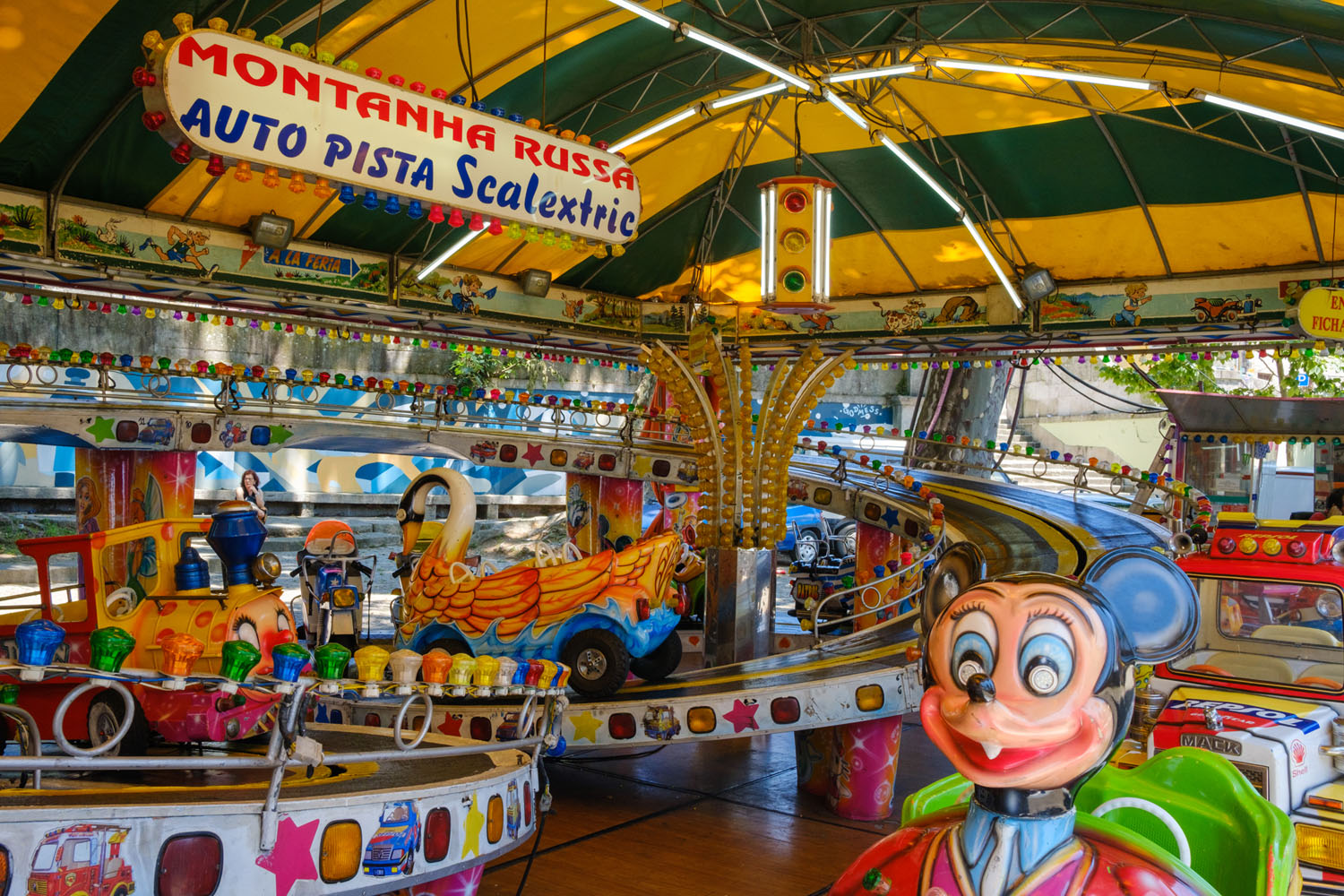
Insane carnival ride on the cliff/bluffs of Porto
But the photographer who has had the largest influence in recent years is backpacker and landscape photographer Ward Ruth. Ward has been a mentor to me in my transition to “real” photography and has taught me so much about both the art and science of photography. He’s also one of the few people out there willing to “tell it to you straight” and offers valuable constructive criticism.

Puzzle-brick breakwater, jetty at Povoação
But at the same time, I try not to let myself be overtly influenced by other photographers – I shoot how I want to shoot and edit how I want to edit – some days with restraint, others with a bit of abandon. If I had to point to any “famous” photographers who I consider inspirations, it would be people like William Eggleston, Vivian Maier, or André Kertész. But it feels almost silly to name individuals – I am inspired by almost any photographer who has a unique vision to share.
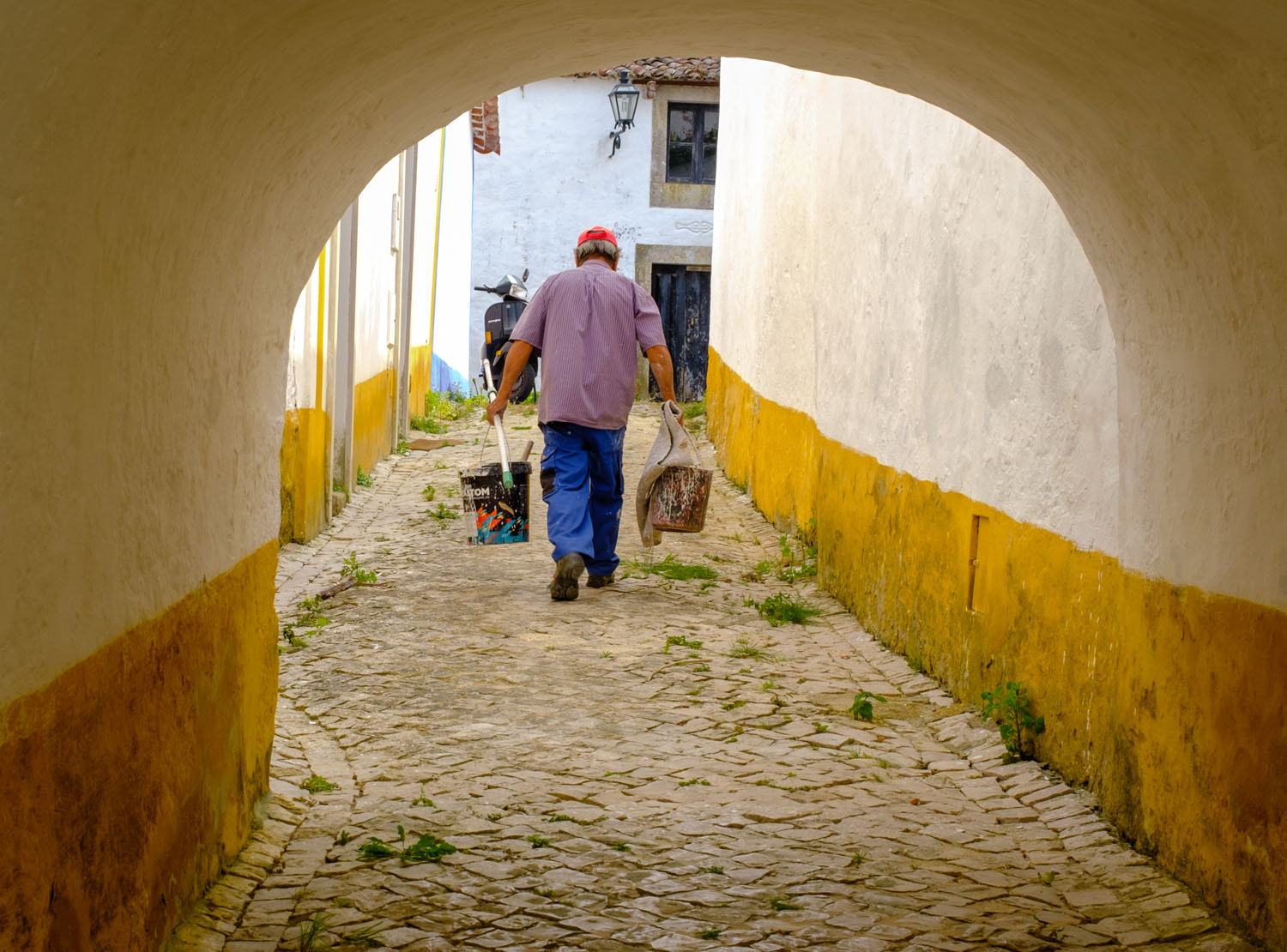
Laborer in the walled city of Obidos
Elsewhere
You can find my work posted 2x daily to the usual platforms:
● Flickr
● Glass
● Vero
● Instagram
● Mastodon
● Threads
I try to remember to add the best ones to my portfolio site at shacker.net.
And I still occasionally post updates to my once-thriving blog at blog.birdhouse.org.
More shots from this Portugal trip can be found in its Flickr album.
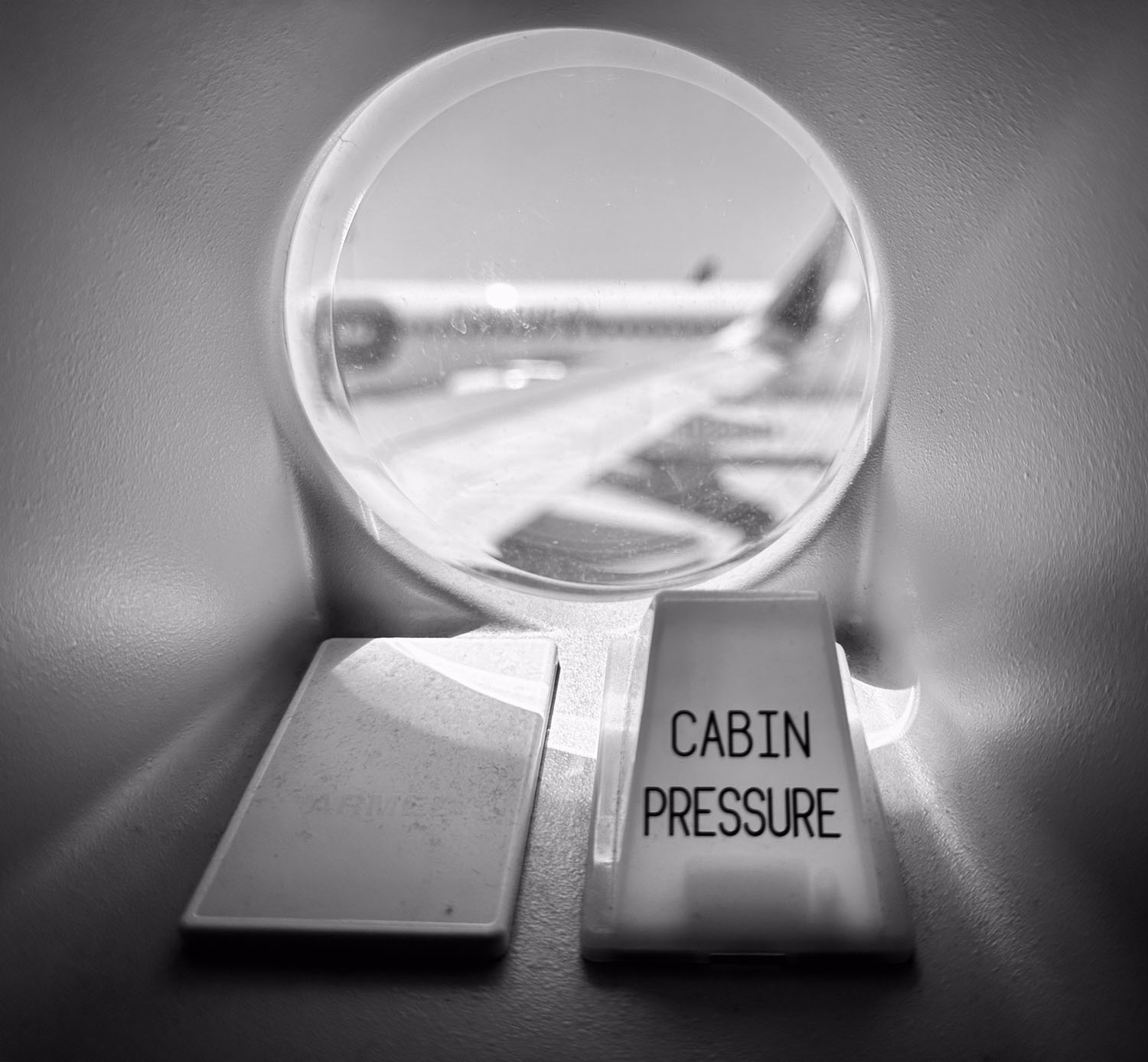
Slightly concerning warning light on the plane trip from Azores to the Portuguese mainland.

From all of us to all of you!

”
I’m Scot Hacker, a cyclist, hiker, and photographer from the east side of the San Francisco Bay Area (“East Bay”). I work by day as a Python/Django developer (programmer), but spend most of my free time exploring and adventuring, always with Fujifilm cameras.”
www.flickr.com/photos/shacker/
glass.photo/shacker
www.instagram.com/shacker/
zirk.us/@shacker
www.threads.net/@shacker
shacker.net/



